
<< Back | Home | Site Map
When the railway to Mildura was opened for traffic on 27-10-1903, as well as achieving the ultimate aim of providing Mildura with a reliable and fast means of sending its valuable produce to the southern markets, it also opened up the vast area of mallee land lying between Woomelang and the Murray River.
The success of the wheat areas opened up by the Ouyen to Kow Plains railway in 1912 was so remarkable that where nearly three million acres of unproductive land did not carry a single head of stock in 1909, a harvest worth nearly 2,500,000 pounds was reaped in 1920.
The area lying west of the Mildura railway line between the Ouyen - Murrayville railway and the Murray River to the north, was described by the 1911 Royal Commission on Border Railways as "first class mallee" and the richness of the soil and suitability for wheat growing was reported. The area was not considered for railway construction at that time until a scheme for supplying water for stock and domestic purposes was prepared by the State Rivers and Water Supply Commission. In February 1921, Mr. A.S. Kenyon, engineer of the Water Supply Department, accompanied by a government surveyor, left Mildura for Kulnine and Ned's Corner Station to survey the country that would be traversed by a railway line between Mildura and the South Australian border. The proposal for a railway had been referred to the
Railway Standing Committee by the Victorian Legislative Assembly.
The Committee arranged to come to Mildura for the purpose of hearing evidence and inspecting the country westward from the Carwarp - Mildura railway to the South Australian border through which it was proposed to construct a railway and to settle discharged soldiers that may desire to take up dry areas for wheat growing. The Committee required evidence on the suitability of the land for the purpose, the average rainfall and the route of the proposed railway.
Three routes were brought under the notice of the Committee: one from Carwarp westward, another from Red Cliffs also running westward, and the third starting from Underbool, on the Murrayville line, and running northward through the Sunset and Birthday Plains country to about 22 miles west of Carwarp, and then running westward to the South Australian border.
On 8-6-1921, the Committee arrived in Mildura by train and that morning examined witnesses in the Shire Hall. A deputation of Merbein settlers urged that the proposed railway start from Merbein as a continuation of the railway to that settlement which opened on 4-7-1910. They claimed that the wheatgrowers of Merbein had to cart their wheat 18 miles over bad roads and that during the previous season, 25,000 bags of wheat were carted to Merbein railway station. In the afternoon of that day, the Committee visited Carwarp by special train (because the condition of the road precluded the use of cars) and on return, a short stop was made at the infant settlement of Red Cliffs to inspect the clearing and camp operations.
The next day, the Committee, in four cars, travelled through "indescribably muddy conditions" to Koorlong and Cadgill, past the ruins of the Harrington homestead, to Widgel. On one occasion it took the whole party of 13 to extract one of the cars from the embrace of a mallee mud hole.
On 10-6-1921, the party travelled by the dry blocks at Merbein to Benetook Tank, from there to Keera Hut, Verley's Tank, and by a new track through Ned's Corner back fence to Pine Tank, and by Beardy Gate and the netting boundary fence from where they proceeded to Renmark. On 13-6-1921, an inspection of the country right back through to Mildura was made and the final day of the inspection was spent at Merbein, Wentworth, Curlwaa and the proposed Nine Mile Settlement (Coomealla).
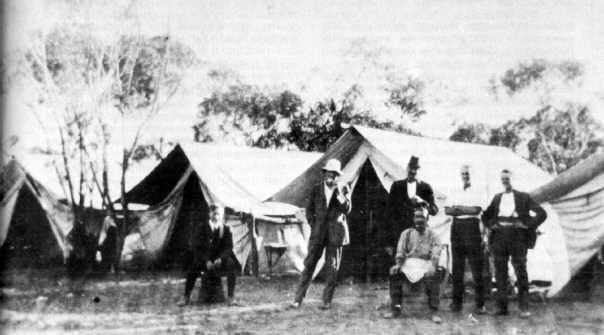
Surveyor's camp at Verley's Tank, 1921. Photo: Mildura Historical Society Collection
The Railway Standing Committee's report on the Millewa railway proposal was laid on the table of the Legislative Assembly on 3-11-1921. The report stated that the Committee concluded from its inspection of the country and the evidence received, together with the results obtained by wheatgrowers just across the South Australian border on land of not such uniformly good quality and with a rainfall greater, that the North Millewa country offered excellent opportunities for settlement and production.
It was therefore recommended that construction of a 5 foot 3 inch railway from Red Cliffs south westwards to a point about two miles north of Koorlong Tank, and thence westward passing near Keera West Tank or thereabouts, would be the best method of aiding settlement of the Millewa North country. The length of this branch railway would be approximately 35 miles and it would make 400,000 acres available for settlement. The route was roughly outlined and the railway construction engineers were to select the most suitable course of the line according to the levels of the country, the grades, suitable sites for wayside and terminal stations and approaches thereto and probable township sites.
The Committee also suggested that the railway survey should be extended 10 or 15 miles westward beyond the terminal point stated so that land surveyors may know how to map out farm allotments and provide roads to fit in with a further extension of the railway towards the South Australian border, probably a few years hence as settlement progresses.
The estimated cost of the 35 miles of railway was 192,500 pounds or 5,500 pounds a mile without rolling stock. This was for the class of line usually built in the mallee, but the Committee suggested that the cost of construction should not exceed 5,000 pounds a mile, or a total outlay of 175,000 pounds, and that the expenditure be kept down by limiting the maximum speed of trains to 20 miles an hour, thus enabling a reduction to be made in the quantity of ballast used.
Economies could also be obtained by restricting equipment at stations to a minimum until traffic justified improvement in accommodation and by leaving the railway unfenced in unoccupied crown lands, which comprised most of the Millewa North country, and where land would have to be surveyed prior to farming allotments being marked out.
There would be no severance to holdings as the railway track would be similar to a public road, and those abutting on the railway should fence their holdings at their own cost, and the Railway Department should be under no obligation to fence the line until the Commissioners consider it necessary for the safety of train running to do so.
Dealing with the proposed alternative routes, the Committee reported that the witnesses in favour of the route from Walpeup to West Keera, while urging that it would maintain the system of parallel in the Mallee railways at distances of 20 miles apart, overlooked the fact that such a line, after passing through the Parishes of Paignie and Wymlet would traverse on its eastern side a fairly large area of country unsuited for settlement, being fit for grazing only.
The Committee had to set apart both the Walpeup and Underbool proposals because inspection showed that there was a much larger area of better country in the northern part of the County of Millewa than in the southern part, and secondly, in the absence of surveys it was not known whether water could be carried into South Millewa for stock and domestic purposes at a reasonable cost.
In view of the urgency of the settlement of the Millewa area, the Committee considered it advisable to build the railway first in the northern part, where domestic and stock water could be made available more easily than in the southern region. The Committee recognised that the Carwarp route offered the lowest railway rates to settlers in North Millewa, but the small differences in these charges as compared with those from and to Red Cliffs was more than outweighed by having connection with a large prosperous centre of population such as Red Cliffs promised to be before long.
The objection to both Mildura and Merbein proposals was that they would be too circuitous a route to the seaboard and thus they would unduly increase Millewa freight and passenger rates. Moreover, the extension westward of the railway from Red Cliffs would give wheatgrowers on the south side of White Cliffs (Merbein) dry farming area, a station near Vicknabush Tank, and reduce their carting distance by about 10 miles, hence the route proposed.
Railway construction was under Authorising Act No. 3174 dated 21-12-1921. The sum of 19,565 pounds for rolling stock was added to the construction expenditure of 175,000 pounds.
Construction of the "Millewa North" line was undertaken by the Railway Construction Branch of the Board of Land and Works, who arranged all details. The surveyors who moved through the area to complete the detailed survey of the line in 1921 for the most part, were working through virgin country. There were very few surveyed roads or boundaries. The choice of route for the railway dictated the location of the future settlements and towns.
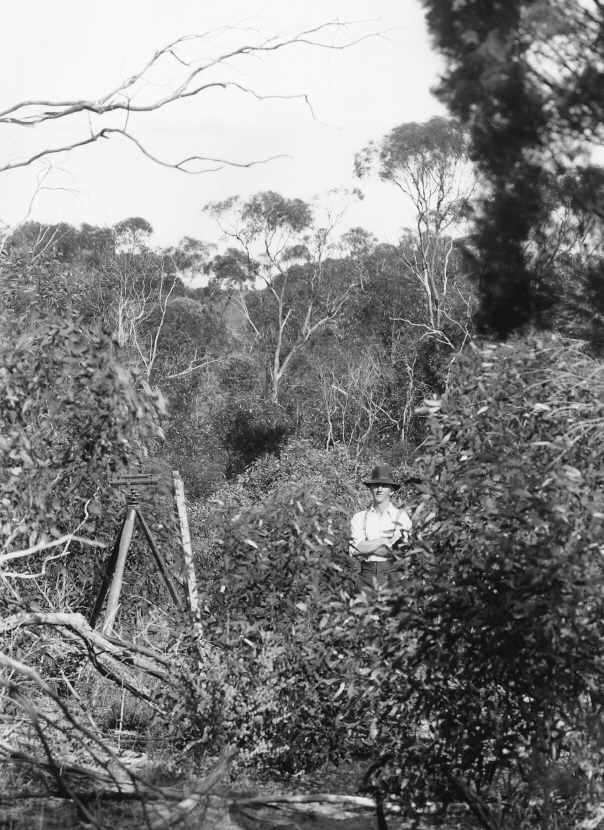
This magnificent self-portrait by surveyor/photographer Wilf Henty has been reproduced in full to allow readers to appreciate the dense mallee scrub confronting railway surveyors. Note the surveyor's instruments. Photo: Wilf Henty, courtesy of John Kiely
Construction work on the Red Cliffs to Millewa North railway commenced on 1-6-1922, and 70 men were reported working at Red Cliffs where the line was to junction with the Melbourne - Mildura railway.
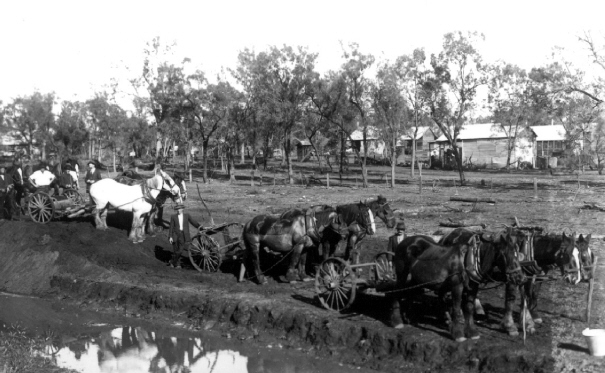
Mr. D.C. McKay's horse team with their implements at the very early stages of construction of the Redcliffs to Werrimull railway. 1922. Photo: D.C. McKay Collection
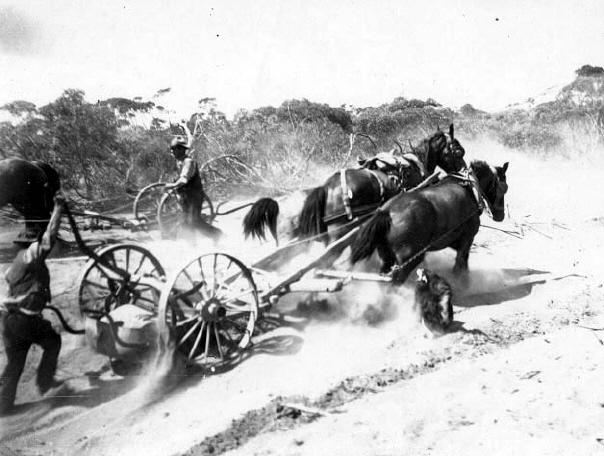
Further out along the new line workmen had to deal with sand hills in their development of the railway formation. Photo: Wilf Henty, courtesy John Kiely
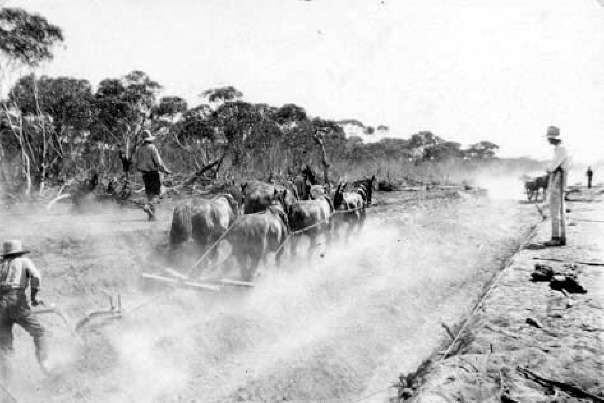
Another fine action shot of formation preparation using horse teams and plough. Work is progressing to form a small cutting. Photo: Wilf Henty, courtesy John Kiely
In August 1922, the State Cabinet announced that it had given its approval to a preliminary expenditure of 50,000 pounds for the construction of 30,000 gallon water tanks in the Millewa and Sunset Country. These water tanks were provided for stock and domestic water purposes. There was no surface water available. They were as essential as the railway to aid settlement of this quite dry area.
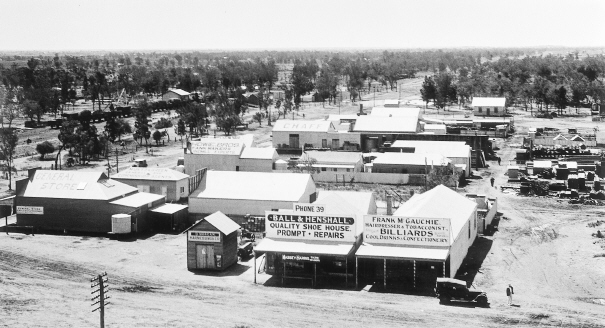
The relatively new settlement and township of Redcliffs was selected at the junction for the new railway into the Millewa. Circa 1924. Photo: Wilf Henty, courtesy John Kiely
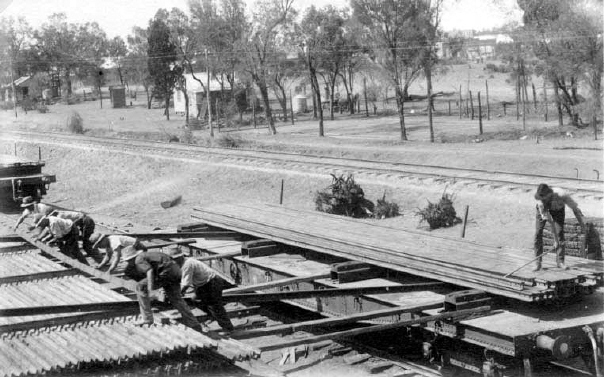
A giant stack of rails and sleepers was created at Redcliffs for building the Redcliffs to Werrimull line. Workmen are transferring rails from Q wagons. 1922. Photo: Wilf Henty, courtesy John Kiely
On 1-8-1922, the Railway Construction Branch indicated that it would be placing the Junction Points into the main line leading to the proposed branch line and temporary sidings. The Junction Points were inserted 375 feet from the up end of the points of the loop at Redcliffs and were facing in the up direction. Until Up and Down Home Signals with Annett lock protection were provided, instructions were issued for the Junction Points to be securely spiked for the main line. The instructions also stated that should it become necessary after the points are placed in position for any train or engine to proceed to or from the new line or sidings, with the following precautions:
1. The work must be performed in clear daylight only.
2. A Scotch Block provided in the branch line must be maintained on the rail and securely padlocked with the key kept in the custody of the Officer in Charge at Redcliffs who is responsible for the security of the Scotch Block.
3. The placing of vehicles in the siding must be performed under the personal supervision of the Officer in Charge at Redcliffs and the points must be unspiked by the Ganger for this to be done. As soon as the trucks are placed in the temporary siding, the engine must return to the station, and the Officer in Charge must see that the points are again securely spiked to lie for the main line.
Construction work proceeded slowly from Red Cliffs and by 15-4-1923 work had advanced sufficiently for the Railway Construction Branch to open the line as far as Taparoo (which later became Pirlta) for the carriage of goods over that section at owner's risk. The stations in this section of the line were Thurla (6 miles), Benetook (12¼ miles), and Taparoo (18 miles), (later to become Pirlta).
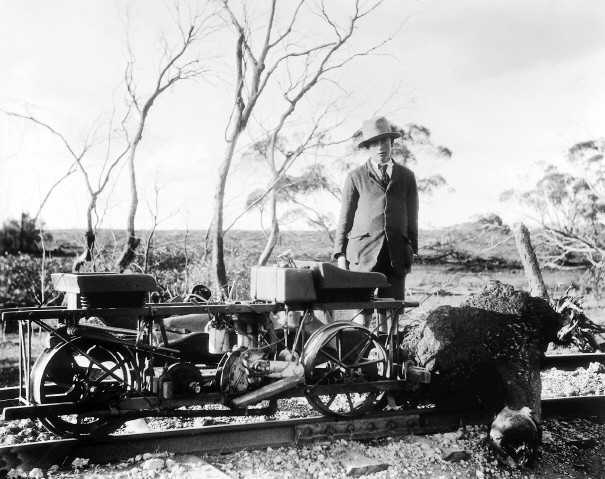
The Redcliffs to Werrimull and Meringur line was known as a developmental line. As the rails pushed through the virgin country, settlers who had won the right to take up an allotment, began the task of clearing their land. In the background is recently cleared mallee, while in the foreground is the new railway and a young man inspecting a mallee root obstructing the motorised trolley. The trolley was used by supervisors during construction or the ganger responsible for maintenance of the permanent way. Circa 1923. Photo: Wilf Henty, courtesy John Kiely
Water trains from Mildura were regularly supplying water to the Mallee centres of Ouyen, Walpeup and Speed, and eight 15 ton I trucks fitted with 2000 gallon tanks were used on the Millewa line for the thirsty construction workers at the rail head.
Due to the river being quite low, the non arrival of 40,000 sleepers which were cut and waiting transport by river steamer from many miles up the Murray River, delayed construction at this point, however by the end of May 1923, the river had risen sufficiently and work was able to progress, reaching Karawinna, 30 miles from Red Cliffs. A feature in the otherwise straight-forward construction task, was a small bridge with three openings of eleven feet to cross an irrigation supply channel at 345 miles 41 chains 41 links.
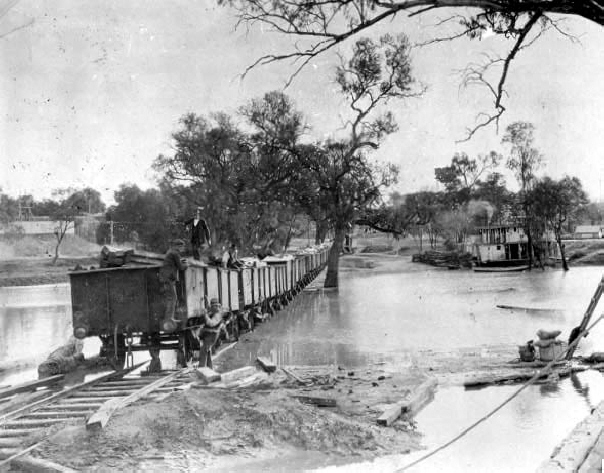
Railway sleepers for use in the construction of the Redcliffs to Werrimull and Meringur line were transported by riverboats and barges to Mildura from various points upstream on the Murray River. The Mildura wharf line, also servicing Anderson's Sawmills, is partly submerged by a high river as a steam locomotive waits to take away another train load. The original Mildura railway water tower, at the end Deakin Avenue on Seventh Street, can be seen in the background as well as the riverboat "Maggie". Circa 1923. Photo: Wilf Henty, Courtesy John Kiely
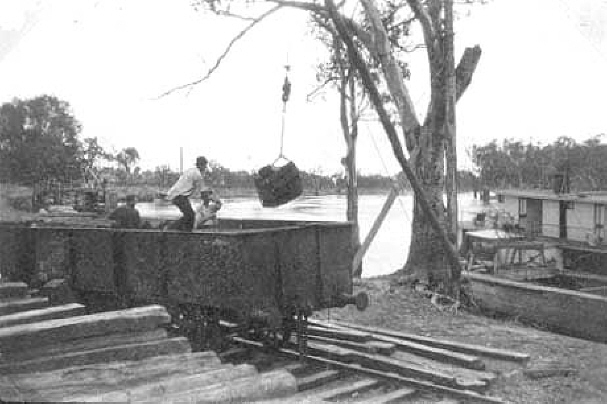
Loading sleepers into an I Truck at Mildura wharf siding. Circa 1923. Photo: Wilf Henty, courtesy John Kiely
Goods in 3 ton lots were now permitted by the Railway Construction Branch to be hauled to Thurla, Benetook, Taparoo and Merrinee at owner's risk. Excellent reports were received stating that the line was progressing through good undulating country timbered with mallee, belar, pine and sandalwood, with occasional plains which were open and well grassed.
The first passenger train on the Millewa line was an excursion to Merrinee arranged by the Come-To-Red Cliffs- Committee on Thursday 18-10-1923. One hundred and fifty passengers travelled on the excursion and after a midday lunch, returned to Red Cliffs arriving at 5.15 p.m.
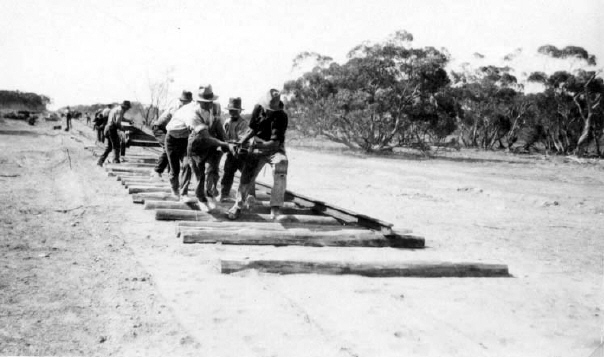
The lifting gang bringing a rail forward for placement on the sleepers. Photo: Wilf Henty, courtesy John Kiely
In November 1923, Mr. M.S.Fernandez, an organiser with the Australian Workers Union, toured the construction work and reported that the line, which had been in course of construction for about 15 months, was now approaching completion. There were about 70 men employed on the job. There were two mess kitchens along the line, and two gangs of men known as the "ballast gang" and the "lifting gang". They were accommodated in rough bush camps with tents for each family. Food and water supplies for the men, their families and the horses had to be carted from Red Cliffs and Mildura. Most of the formation for the line was constructed using horses and scoops, ploughs and rollers.
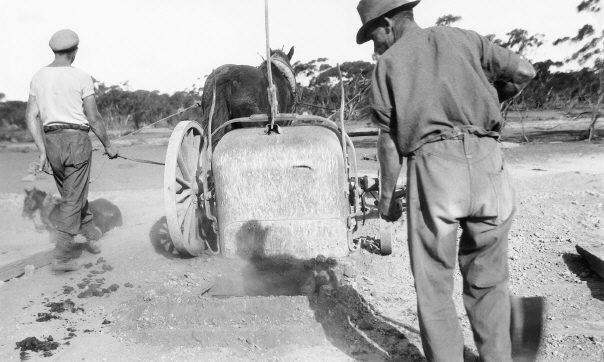
A scoop discharges its load of ballast into a railway wagon waiting below the filling hole at the 9 mile 40 chains ballast siding. Circa 1923. Photo: Wilf Henty, courtesy John Kiely
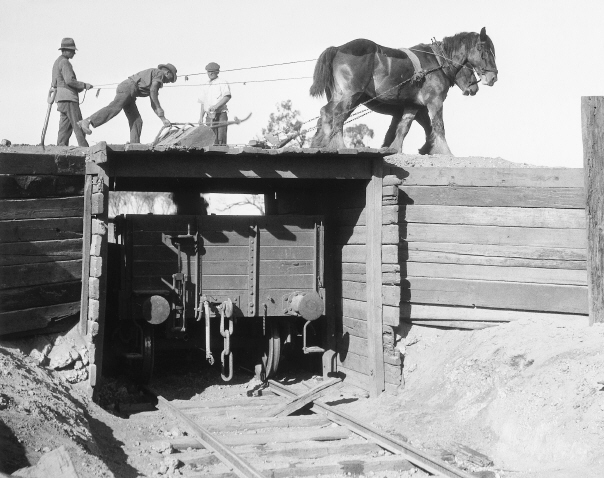
There were three locations where limestone ballast was obtained. Sidings were constructed on the limestone outcrop and an over-rail ramp built to enable loaded scoops, hauled by horses, to discharge ballast into wagons below. Circa 1923. Photo: Wilf Henty, courtesy John Kiely
Shelter sheds were erected at stations located about 6 miles apart. These stations were named respectively from Red Cliffs, Thurla, Benetook, Pirlta, Merrinee, Karawinna and Werrimull. Merrinee was the "busiest" station owing to machinery being landed there for the pumping station at Lake Cullulleraine, about 18 miles north of Merrinee, in the direction of Lock 9.
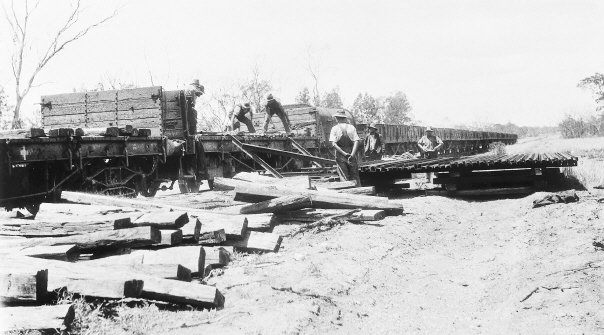
Rails are sleepers are being unloaded from a construction train from Mildura. Circa 1923. Photo: Wilf Henty, courtesy John Kiely
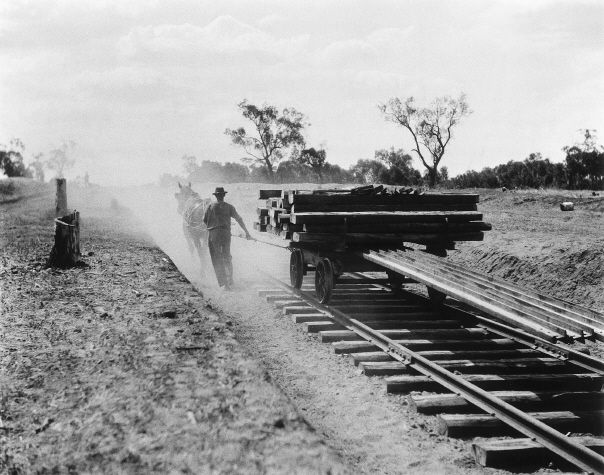
A railway construction worker uses a horse to haul a construction trolley loaded with rails and sleepers along the newly laid track. Circa 1923. Photo: Wilf Henty, courtesy John Kiely
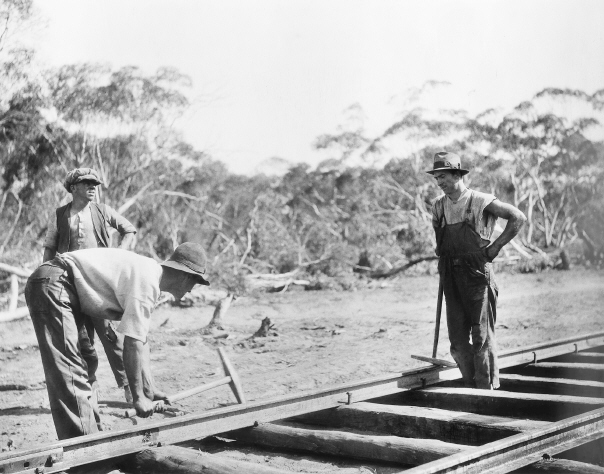
After the track bed was prepared by horses pulling ploughs, scoops and rollers, the sleepers were laid out, rails placed into position with the gauge of 5 feet 3 inches, fishplates were bolted at the joints and dog spikes hammered into drilled holes to fasten the rails to the sleepers. The sweat and muscle of building railways in the 1920's is captured in this scene of construction between Redcliffs and Werrimull. Circa 1923. Photo: Wilf Henty, courtesy John Kiely
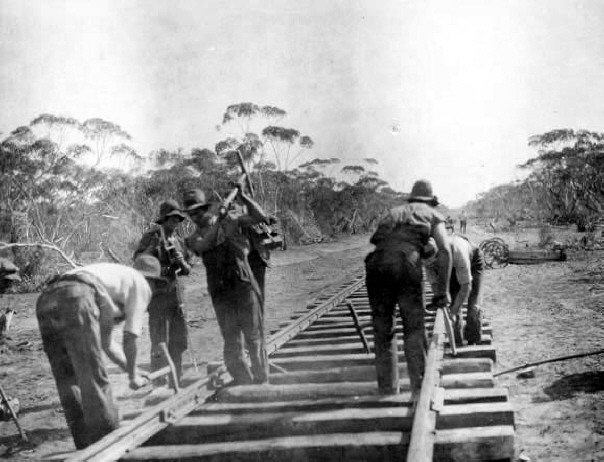
Another view of track construction in progress. Photo: Wilf Henty, courtesy John Kiely
The track was constructed with 60 pound AS rail in 40 and 45 foot lengths with some 22 foot 6 inch lengths. There was also Queensland and Tasmanian pattern 60 pound steel rails 30 and 40 foot long with limestone and sand ballast. The steepest gradient was 1 in 100 and train speed was limited to 25 miles per hour. Cattle pits were provided at the end of station grounds and the line was only fenced at station grounds and between 6m 22c 30l and 6m 56c on the down side and between 6m 22c 30l and 6m 67c on the up side. A telephone line was also provided.
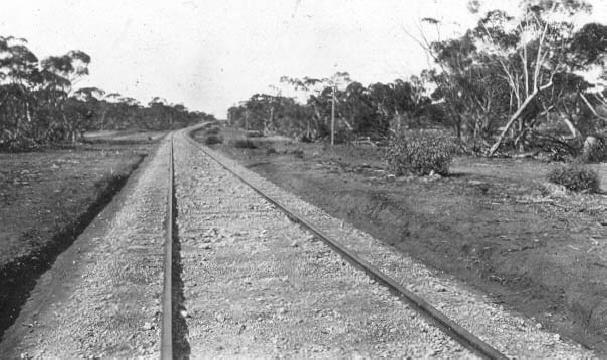
A completed section of track on the Redcliffs to Meringur line. Photo: Wilf Henty, courtesy John Kiely
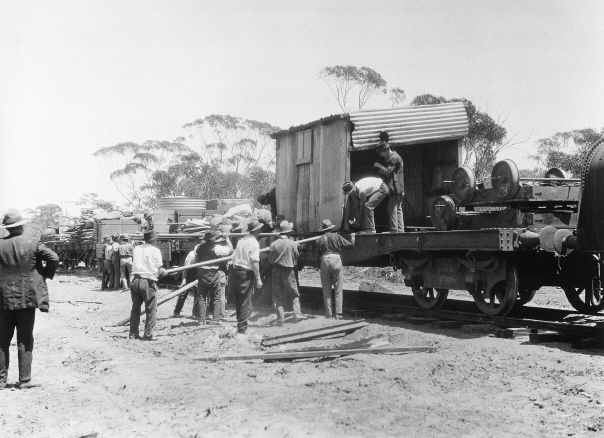
Construction camps were moved forward as construction progressed. Wilf Henty has captured a construction train that has been propelled by its locomotive onto unballasted track to enable a camp site to be advanced to the rail head. A shed, track trolleys, water tanks and other camp requirements are on the flat-top wagons while the end of a 2,000 gallon water tank can be seen to the right. Circa 1924. Photo: Wilf Henty, courtesy John Kiely
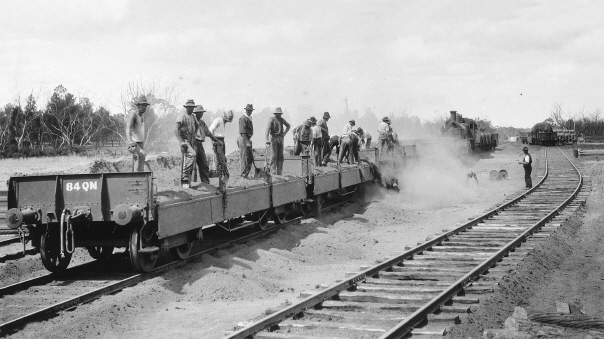
At Werrimull workmen unload gravel from QN wagons to provide a level surface in the station yard. The Dd locomotive has a number of water tanks to ensure the locomotive and workmen are able to quench their thirst during the summer of 1924. Photo: Wilf Henty, courtesy John Kiely
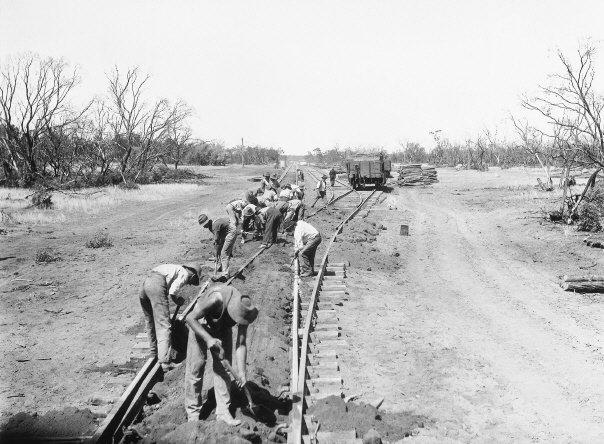
It was early 1924 when construction reached Werrimull. In this scene workmen are spreading gravel in the points at the down end of the yard. Werrimull consisted of a crossing loop and an 18 chain siding. The developmental nature of the Millewa railway can be recognised by the absence of any clearing of vegetation beyond the railway reserve. March 1924. Photo: Wilf Henty, courtesy John Kiely
Mr. C. Roscholler, the Train Running Officer for the Maryborough railway district, accompanied by Mr. O'Neill, the District Locomotive Inspector, arrived at Red Cliffs on 19-3-1924 in connection with the future working of the Red Cliffs - Werrimull line. The next day, with the two officials on board, a loaded train left Red Cliffs for the terminus in order to test the time schedule for the line.
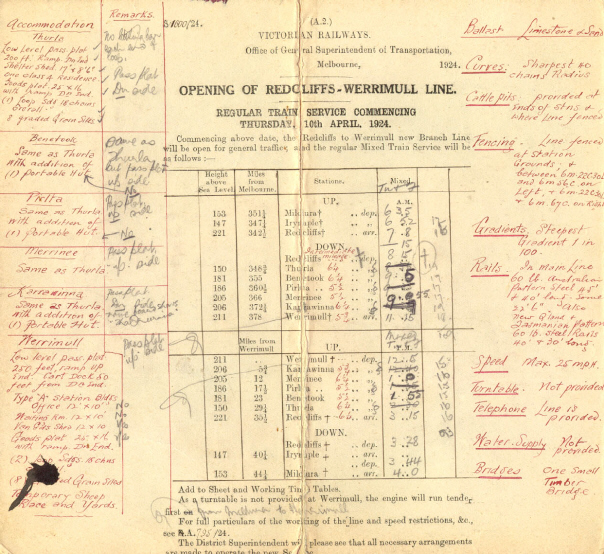
The draft staff circular (S/1600/24) of the timetable for the opening of the Redcliffs - Werrimull Line with details added by Mr. H. Cooke, Chief Timetables Officer. This is the actual document used by Mr. Roscholler to adjust times during the timetable trial on 20-3-1924 referred to in the text. Source: Bruce McLean Collection
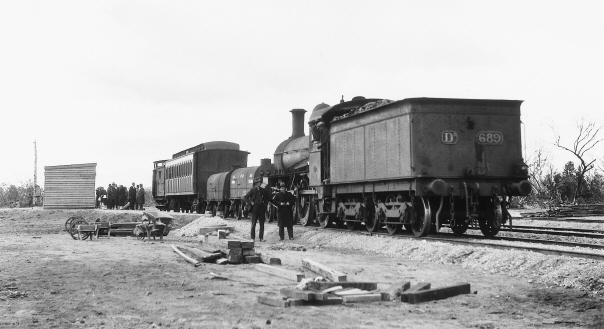
DD689, with two 2,000 gallon water tanks, 3AB carriage and Z guard's van, formed the special train bringing Victorian Railways officials to Werrimull on 20-3-1924 to test the time schedule for the line. A van goods shed, low level platform with cart dock had been constructed by this time. 20-3-1924. Photo: Wilf Henty, courtesy John Kiely
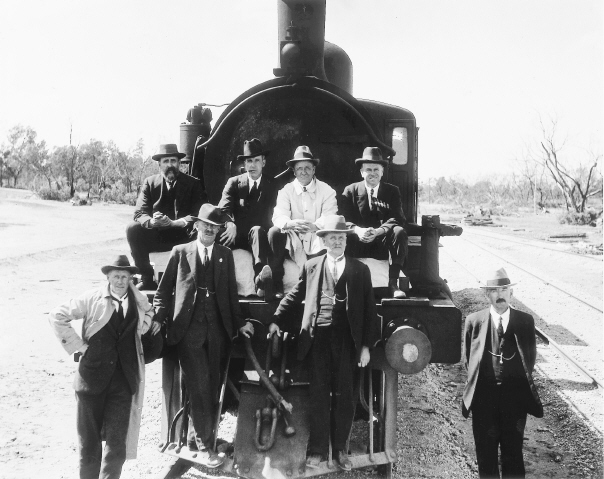
Victorian Railways officials posing on the front of the Dd locomotive that took the special train from Redcliffs to Werrimull for timetable trials on 20-3-1924. Photo: Wilf Henty, courtesy John Kiely
The line continued to be served by the construction train, which left the construction camp siding adjacent to the junction of the Werrimull branch line, until the official opening of the line on 11-4-1924.
No ceremony of any kind accompanied the opening, but a party of Red Cliffs residents and officials, including representatives of the State Rivers and Water Supply Commission and the Trader's Association, made the first journey at the invitation of the Railway Department. They were accompanied by Mr. Roscholler, Mr. Henty of the Construction Branch and Mr. Considine, the Red Cliffs Stationmaster, who was in charge of the administration of the line. A picnic lunch was held at Werrimull and the interval before departure of the train filled in with an inspection of the surrounding country which had yet to be subdivided for settlement.
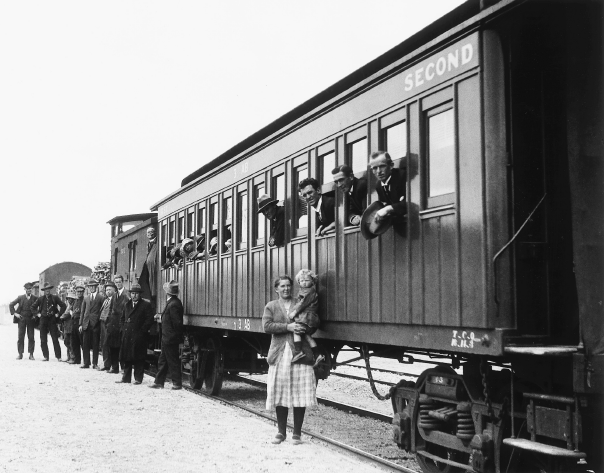
The first official train to Werrimull was a special train conveying officials and invited guests on 20-3-1924. Officials and passengers pose for the camera on the historic occasion which was not marked with any official opening ceremony. Photo: Wilf Henty, courtesy John Kiely
In December 1923, the Railways Standing Committee, on a specific reference in regard to an extension from Werrimull to The Hut (later to be named Meringur), approved of a further 15 miles of construction to the latter point.
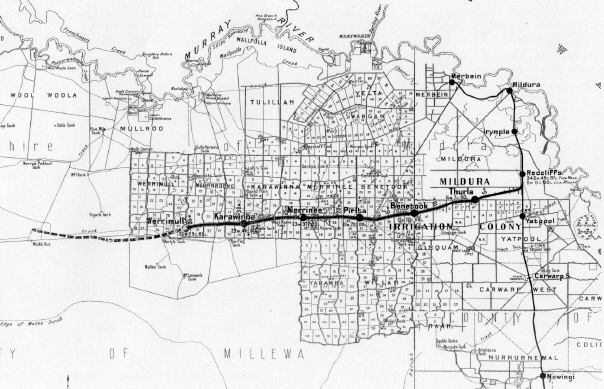
Map of the Millewa area showing the railway from Redcliffs to Werrimull and the proposed alignment for the extension to Meringur (The Hut). June 1923. Source: Parliamentary Standing Committee on Railways Report
After the line to Werrimull had been completed, construction continued until August 1924, carrying the line to a point 5 miles further west, however the work was temporarily suspended for a time owing to the greater urgency of completing the extension from Hopetoun to Patchewollock to serve settled wheat growing areas, the necessity of completing the line from Merbein to Abbotsford Crossing (Yelta) within a specified time under the Border Railways Agreement, and to the scarcity during the wheat transport season of trucks for conveying construction material.
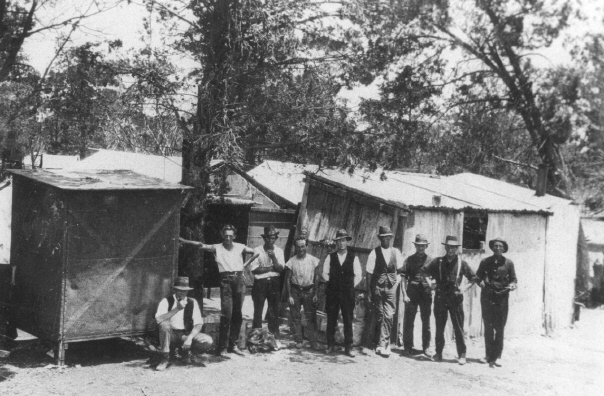
Construction camp for the Werrimull to Meringur section. Circa 1923. Photo: Wilf Henty, courtesy John Kiely
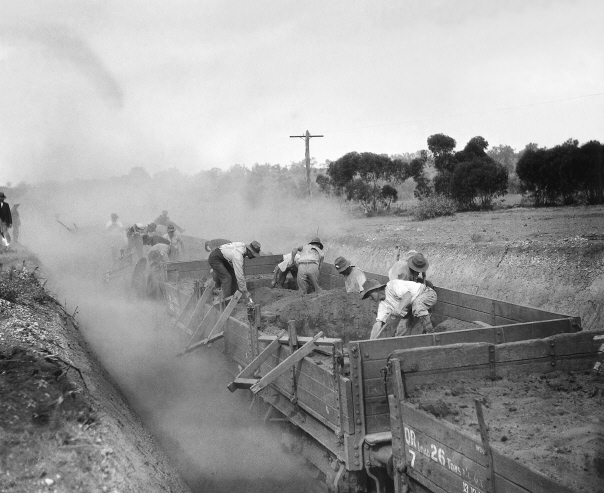
Discharging ballast from high sided QR wagons was a tough and dusty assignment for workmen who had to rely on shovels to empty each load. In this scene, limestone and sand ballast is discharged to the centre of the new track. It was then shovelled between the sleepers and packed underneath each one. Circa 1925. Photo: Wilf Henty, courtesy John Kiely
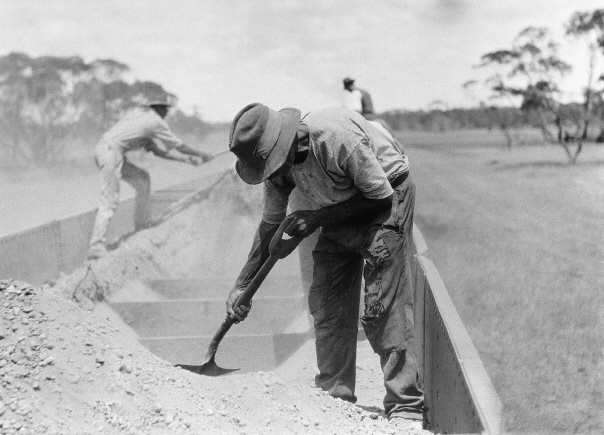
In this dusty scene, workmen are shovelling limestone and sand ballast through unloading hatches in the floor of QN wagons. Circa 1925. Photo: Wilf Henty, courtesy John Kiely
By June 1925, 50 workmen were engaged on the continuation of construction and by mid-August the rails had reached Meringur, 50.5 miles from Red Cliffs.
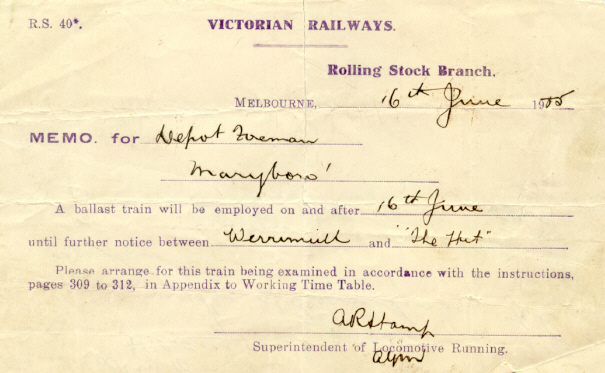
Memorandum issued by the Superintendent of Locomotive Running to the Depot Foreman, Maryborough, advising of the use of ballast trains between Werrimull and "The Hut" (Meringur) from 16-6-1925. The ballast trains would have been required by the Railway Construction Branch of the Board of Land and Works, the memorandum informing the Depot Foreman that his rolling stock would be running on a line under construction and he would have to make suitable arrangements for rolling stock examinations. Source: Victorian Railways, Bruce McLean Collection
"Sunraysia Daily" newspaper of 18-8-25 reported: "The siding at the head of the line is named Meringur and as (Driver) Ben Hall and his DD engine arrived here for the first time last week, he stopped his train, got down from the cab, looked around, and said, "so far, so good". He was at the 50.5 mile peg from Red Cliffs. Engineer-surveyor Henty must have been pleased when he knew his job was done.
The scene in the scrub as the engine came to a stand where the rails ended was a pretty one, for at this point the line is flanked by beautiful bulokes and pines.
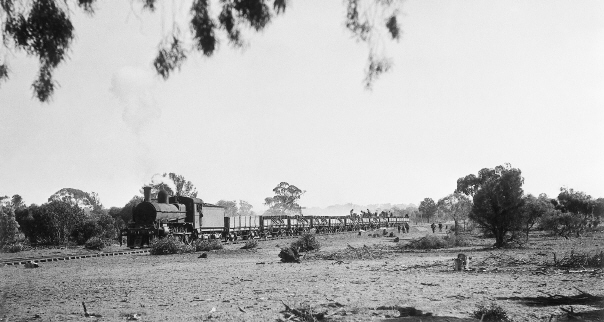
A Dd locomotive at the head of a ballast train discharging ballast on the newly constructed line between Werrimull and Meringur. Circa 1925. Photo: Wilf Henty, courtesy John Kiely
The line is laid with 60 lb. rails and is of Victorian 5'3" gauge. Twenty men under foreman E. Bye are putting in the siding and 100 men are still employed along the route. Their wages are 15/7 a day, "nippers" receiving 7/8 a day. Mr. Henty worked as a "nipper" on the Mildura line."
Meanwhile, the Chairman of the Victorian Railways Commissioners, Mr. Harold Clapp visited Werrimull on 22-8-1925 as part of his annual tour of inspection of north- west Victorian railway lines. A deputation at Werrimull asked Mr. Clapp for three trains a week instead of two, the erection of trucking yards for loading cattle, the installation of a crane for the goods yard and that a Stationmaster or Porter be stationed at Werrimull. Mr. Clapp said he did not think that the traffic on the line warranted three trains a week, and he could not give a definite answer in regard to the other requests.
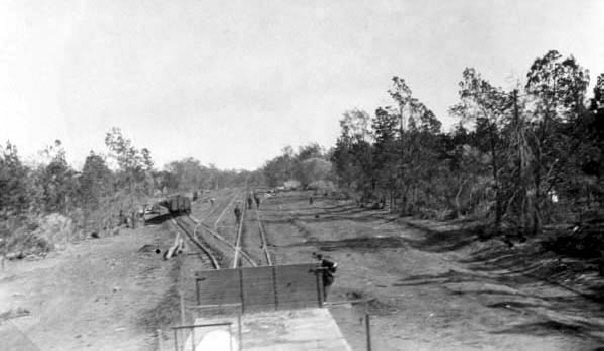
Construction activity at Meringur. The loop line and siding have been laid and ballasting of the station yard area is underway. Note the pine forest setting that makes Meringur such a picturesque mallee location. October 1925. Photo: Wilf Henty, courtesy John Kiely
A special train was scheduled to Werrimull and beyond to the terminus at "The Hut" on 7-10-1925 to inspect the new line. On Saturday 30-10-1925, the Werrimull to Meringur railway was opened for traffic without ceremony. A special train with Railway Department officials and guests travelled to Meringur. Much interest was taken in the fine stretch of pine country that was passed through and appreciation of the "commodious concrete cottages" erected for the station caretakers was expressed. At Meringur, considerable comment was caused by the site of the stockyards erected at the station.
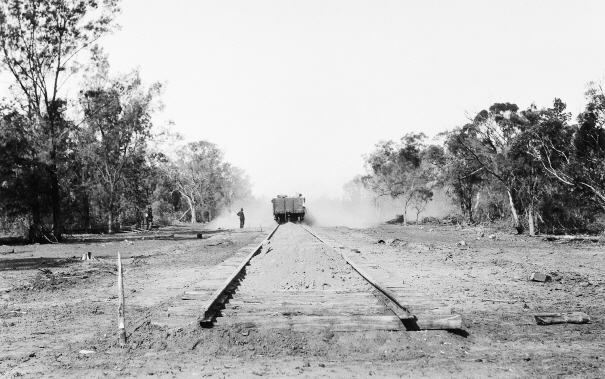
At the end of construction at Meringur, ballast has been deposited on the new permanent way for spreading and packing between the sleepers. The terminus was at 353 miles 52 chains and 34 links from Melbourne. Circa 1925. Photo: Wilf Henty, courtesy John Kiely
The extension to Meringur was authorised by Act No. 3329 and the total cost of the line from Red Cliffs to Meringur was 190,851 pounds (Red Cliffs to Werrimull 228,983 pounds; Werrimull to Meringur 61,868 pounds). Stations on the extension were Bambill, Yarrara and Meringur.
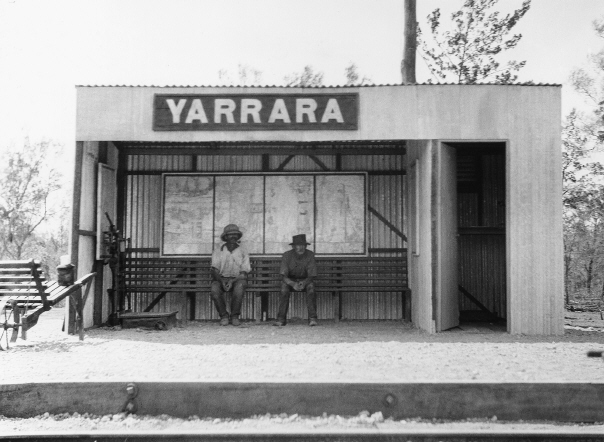
Yarrara was the name given to the second siding on the Werrimull to Meringur extension. This scene captures the basic passenger facilities provided at most sidings - a low level platform, Mallee shelter and telephone locker, scales and barrow. More substantial buildings were erected at Werrimull and Meringur. Circa 1924. Photo: Wilf Henty, courtesy John Kiely
In September 1927, a reversing triangle was installed at Meringur to enable steam engines to reverse, thus eliminating the long tender-first running from Meringur to Mildura. Reversing triangles were used as an alternative to a turntable and very few were constructed in Victoria.
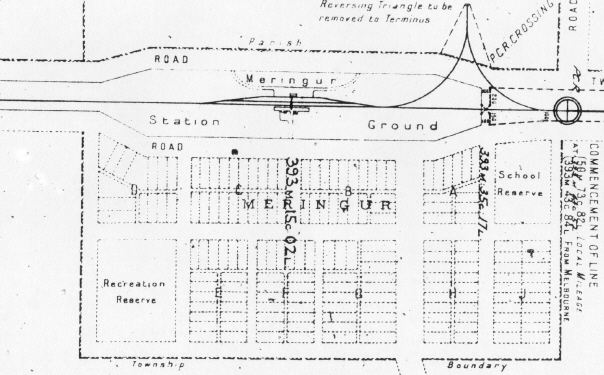
Meringur station ground and township plans. The reversing triangle notation was later overturned and the triangle remained at Meringur. Source: Railway Construction Branch
Item |
Redcliffs - Werrimull |
Werrimull - Meringur (The Hut) |
Date of start of construction |
1-6-1922 |
26-2-1924 |
Date of opening for public traffic |
11-4-1924 |
30-10-1925 |
Time of construction |
22.33 months |
20 months |
Rate of construction |
.63 months per mile |
1.32 months per mile |
Length of line |
35 miles 32 chains 45 links |
15 miles 14 chains |
Costs |
Pounds |
Pounds |
Surveys |
£1,022 |
£263 |
Clearing and grubbing |
£1,431 |
£864 |
Fencing |
£72 (6.6 miles) |
£216 (3.33 miles) |
Cattle pits |
£493 (16 No.) |
- |
Cattle pits, gates, notice posts etc. |
- |
£425 Cattle pits 6 No. Caution boards 3 No. Whistle posts 3 No. Mile and half mile posts 31 No. |
Station gates |
£216 |
- |
Wicket gates |
£45 |
- |
Mile and half mile posts |
£80 (70 No.) |
- |
Whistle posts |
£31 (32 No.) |
- |
Caution boards |
£72 (16 No.) |
- |
Culverts timber |
£145 |
£36 (2 No.) |
Culverts - concrete |
£918 (less £107 paid by State Rivers & Water Supply Commission) |
£97 (less half cost paid by State Rivers and Water Supply Commission) 44m 6c 52l |
Earthworks, creek diversion, road approaches etc |
£8,642 |
£4,681 |
Metalling and gravelling limestone |
£943 |
£472 |
Ballasting - sand and limestone |
£9,233 |
£3,499 |
Sleepers 8'6"x9"x4½" grey box |
£22,986 (80,857 No.) |
£12,075 (36,338 No.) |
Crossing timber |
£406 (898 No.) |
£594 |
Permanent way material |
£49,959 |
£21,786 |
Points and crossings |
£963 (14 No. sets) |
£558 |
Freight on per way material |
£4,519 |
£2,178 |
Laying per way |
£5,609 |
£2,372 |
Terminal station buildings and platform |
£338 |
£413 |
Roadside stations |
£762 (5 No.) |
£300 (2 No.) |
Departmental residences |
£4,161 |
£1,419 (concrete 2 No.) |
Water supply |
- |
£439 |
Livestock yards |
£108 (1 No.) |
£93 (1 No.) |
Telegraph |
£1,960 (8,287 poles) |
£1,180 (367 poles) |
Engineering and supervision |
£5,102 |
£3,922 |
Signals and safety appliances |
£1,355 |
£533 |
Additions to junction station |
£1,216 |
£272 |
Improved conditions for workmen |
£4,076 |
£524 |
Tools and plant |
£2,146 |
- |
Ballast for the Redcliffs to Werrimull section was obtained from the following sources:
* Limestone from a pit at 9 miles 40 chains. One set of points and 18 chains of track.
* Sand from a pit at 24 miles 40 chains. One set of points and 20 chains of track.
Note: A pit was established at 5 mile 40 chains. Points were laid in but no material was taken from this location.
* Limestone and sand was also taken from deposits beside the line at various places. It was shovelled or scooped onto the line from natural deposits.
Ballast for the Werrimull to Meringur section was obtained from the following sources:
* Limestone from a pit at 10 miles 70 chains. A siding was laid in and dismantled at the completion of the section.
* Sand from a pit at 36 miles 40 chains.
* Ashes from the Way & Works branch supplied in trucks at Merrinee.
Sleepers for the Redcliffs to Werrimull section were obtained from Mildura, having been forwarded by barge from Campbell Island (Murrabit) and Murray River bends 43,754, Bealiba district 9,164, and Tooborac 27,688. Crossing (points) timbers came from Campbell Island and the Crossover district (Neerim South).
Sleepers for the Werrimull to Meringur section were obtained from the following locations: Red gum sleepers from River Murray district, box and ironbark sleepers from Axedale, yellow stringy bark from Gelliondale, round top box and iron bark from Tooborac, Moonambel and Carapooee.
Rails supplied were: 60 pound new ex Dorman Long & Co.
60 pound new ex Broken Hill Co. in Queensland, Tasmanian and Australian standard patterns.
Some 66 pound serviceable rail (3,358 lineal yards).
Two sets of staff locks and catches were provided at all stations except for Werrimull and Meringur which were provided with home signals (Werrimull 2 No., Meringur 1 No.) and plunger locks.
A water supply was provided at Bambill for locomotive watering purposes and consisted of 434 lineal feet of four inch G.I. pipes and 164 lineal feet of four inch G.W.I. pipes, a C.I. Fullway meter with dirt box, gauge and guide post, oil engine and pump house, and 10,000 gallon tank with jib and crane and tank stand. The cost for these works was £843 with £420 charged to the Redcliffs to Werrimull section and £423 charged to the Werrimull to Meringur section.
A temporary material siding was provided at Redcliffs and was later taken over by the Victorian Railways as portion of the junction. It was known as the Construction Siding.
A temporary coal stage and ash pit was also provided at Redcliffs during the construction period.
The extension of the railway beyond Meringur towards the South Australian border was discussed by a meeting of settlers with Mr. A.G. Allnutt M.L.A. on 3-5-1927. It was stated that the land was settled 18 miles west of the terminus of the line at Meringur and that in the Parishes of Karween and Morkalla alone there were at least 8,000 acres that would be put under crop that year.
Later, Mr. Allnutt interviewed the Minister on the question of the Railways Standing Committee making a weekend visit to Karween and Morkalla.
The Railways Standing Committee visited the area in October 1927, primarily to enquire and report on the question of connecting the districts lying between the Ouyen to Mildura railway and the South Australian border with the existing railway system. The result was that the Committee recommended a 35 miles line be constructed from Nowingi west to Raak Plain, south of Rocket Lake, some 20 miles south and parallel to the Millewa North railway.
In the meantime, settlement of the country to the west of Meringur had proceeded following the surveys of the area and the railway route, and it appeared that with the construction of the Nowingi to Millewa South line, the settlers to the north would be left without the railway they had confidently expected would be provided.
A well attended and enthusiastic meeting of settlers representing three parishes west of Meringur was held on 22-1-1928 at Morkalla Tank to discuss ways and means of furthering the extension of the Red Cliffs - Meringur line to Morkalla. The "Meringur - Morkalla Railway Extension League" was formed as a result. The action of the Railways Standing Committee in recommending the construction of the line through unsettled country west of Nowingi, leaving in abeyance the extension of the Meringur line (through country settled for two years) was considered to be a mistake.
The League arranged for a meeting on 19-8-1928 at the Karween State School and at the end of the month Mr. Allnutt M.L.A. was able to report that the Minister of Railways (Mr. Tunnecliffe) moved that the question of connecting the district lying west of the Red Cliffs - Meringur railway be referred to the Railway Standing Committee.
In September the previous year, the Committee had recommended, after inquiry, that negotiations be opened with the South Australian government for an extension of the line north of Peebinga, but this was not acceptable to South Australia.
It was hoped that a recommendation would be submitted to parliament almost immediately, however a request from settlers in the area for further evidence to be taken on the extension, including a deviation northwards towards Pine Tank, meant that the Committee could not visit the Millewa until 1929, consequently, if recommended, the extension would not be constructed until 1930.
On Wednesday 27-3-1929, the Railways Standing Committee inspected the Karween - Morkalla area taking evidence on the goods platform at Meringur station, where impromptu seating accommodation was arranged out of bags of wheat and timber placed on empty cases. A large number of district residents, some travelling from as far as South Australia attended, and the novel sight was witnessed of evidence being taken on oath with the public present wearing hats and contentedly enjoying "pipes of peace". The Committee slept in a special railway carriage at Meringur the night before.
In its report to parliament, tabled on 28-8-1929 in the Legislative Assembly, it was estimated that the cost of the extension from Meringur to Morkalla, a distance of 9 miles, 52 chains, was 47,500 pounds and that approximately 226,000 acres would be served. It was estimated that the line would show a loss on the first year's operation of 1,577 pounds.
An exceptionally strong reason urged by settlers in support of the extension was that misleading information was placed before them on the Land Department's plans inviting applications for allotments. The Committee felt there was a strong moral, if not legal, claim for the construction of the line because of this factor alone.
A recommendation was therefore made that of the total cost of the line and rolling stock of 49,020 pounds, an amount of 29,020 pounds be provided from the Developmental Railways Account as a free gift, leaving only 20,000 pounds on which interest would be charged. Thus the estimated loss on the first year of the line would be only 54 pounds. In these circumstances the Committee recommended the construction of the line.
A change of government however, resulted in the Committee's report not being acted upon. On 2-5-1930 a newly reconstituted Railway Standing Committee began another inspection of the Millewa country, this time to enquire and report on either an extension of the railway from Meringur to the Paringa line in South Australia, or from Meringur to Morkalla. In its report to parliament presented on 25-5-1930, the Committee confirmed its previous recommendation that the railway be extended from Meringur to Morkalla, but added that it did not consider it fair to judge the district according to the present drought conditions. The Committee added that it was expected there would be co-operation between the various State departments to ensure that land settlement and the provision of water and railway facilities would advance simultaneously in this area, thus avoiding the economical and financial waste that was incurred with the Nowingi to Millewa South railway.
A Bill for the construction of the extension was introduced to the Legislative Assembly on 20-5-1930 and passed all stages without amendment, the Authorising Act being No. 3862.
It was hoped that, as no great engineering difficulties were involved, the new railway would be available in time for the next harvest, and that no blocks would be further away than 10 miles with 173,000 acres being served. The work would take about four months to complete and sleepers would be readily obtainable from the dumps at Nowingi and Mildura and sufficient ballasting material was available at Benetook for the extension.
Construction of Morkalla extension commenced on 5-6-1930. Surveyors visited the district the previous week, local men were engaged and portable offices constructed. Special trains conveying sleepers from Mildura and Nowingi arrived at Meringur regularly and 60lb rails released during relaying of the Ouyen - Carwarp section of the Mildura line were railed from Nowingi. It was estimated that 20,000 sleepers would be used on the extension. By mid-June a total of 30 men had cleared nearly the whole of the distance to Karween, the station to be situated half way between Meringur and Morkalla.
Rail laying commenced during July, sleepers and rails being conveyed from Meringur to the railhead by means of a horse drawn trolley. Later Construction Branch engineers adapted a farm tractor and rail wagon underframe for rail travel and eliminated a considerable amount of light engine running from Mildura to the railhead. Loads of 150 tons were capable of being hauled on a favourable track. The first mile was completed by the end of July and it was reported that there was plenty of ballast available along the line. The settlers took a keen interest in the work and groups could often be seen watching the laying of the rails.
The District Superintendent of Railways, Mr. H.E. Russell, along with other officials of the Victorian Railways, inspected progress on the extension on 5-8-1930 travelling to the railhead in a Dodge Inspection Car - a motor car specially equipped with railway wheels.
The Chairman of Commissioners (Mr. Harold Clapp), inspected the new work on 23-8-1930 when his special train journeyed to Meringur. Mr. Clapp was reported to have remarked that the crops were looking much better toward the end of the line.
By mid-September the rails had been laid a distance of four miles. A progress report on the construction of the extension in November stated that it was now possible to convey harvesting machinery to Karween. The machines were conveyed on a K class open truck and removed without the assistance of cranes. At Karween, limestone approaches had been prepared in readiness for the carting of heavy wheat traffic, a loop had been laid down for shunting purposes and preparations were made for the installation of a weighbridge.
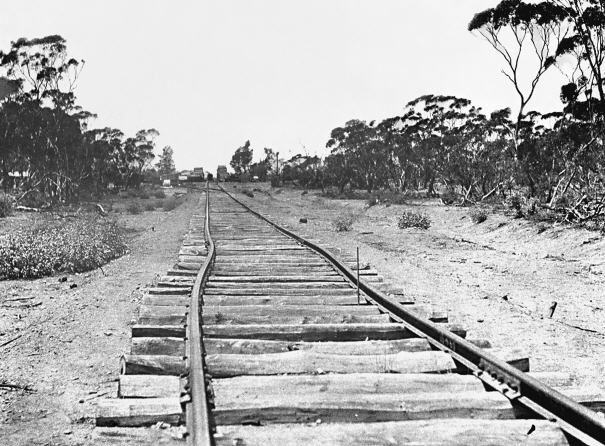
Track construction on the Down side of Karween. Note the locomotive in the background. Photo: John Thompson Collection
At Morkalla, 20 men were engaged on construction work. Grading the site for the new station was in full swing and the approaches were being constructed for the carting of wheat. Telephone poles had arrived for the construction of the telephone line from Meringur. In early December 1930, a full gang of men were engaged on the finishing touches to the line at the terminus. This work was expected to be completed within a fortnight or three weeks by which time it was anticipated that there would be a big stack of wheat ready for consignment to the seaboard. "Sunraysia Daily" suggested that Morkalla would be "one of the leading towns along the line before long".
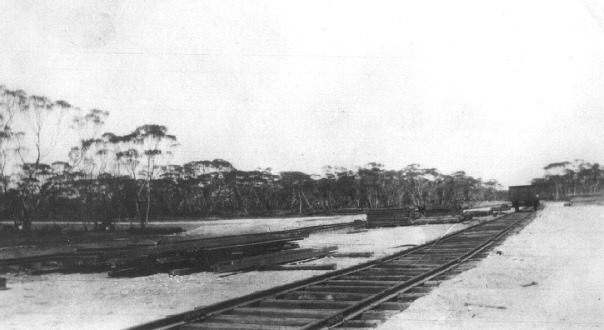
Construction of the main line and siding at Morkalla in 1930. Photo: Courtesy Margaret Kelly
By January 1931 the gang employed on the construction was greatly reduced in number. The camp established at Meringur was almost vacated with the major job of track construction completed. On 29-1-1931 it was announced that the Construction Branch would allow wheat to be hauled from Karween in truckloads at owner's risk and at the end of the month this service was extended to Morkalla, subject to a minimum loading of three tons. This situation remained until Thursday 18-6-1931 when the extension was opened for general traffic.
The opening was preceded a week before by an inspection of the new line by Mr. H.E. Russell, District Superintendent; Mr. Goudie, Assistant Chief Engineer; Mr. Cocks, Superintendent of Goods Train Traffic; and Mr. Taylor, Construction Engineer.
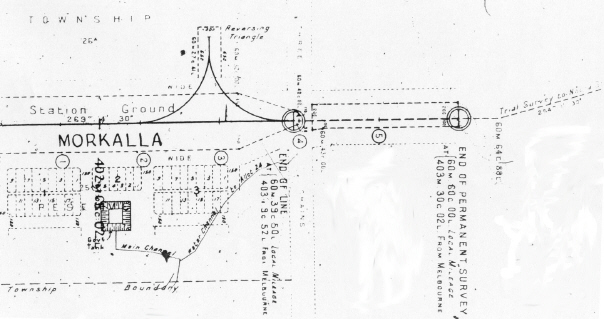
Plan of the reversing triangle proposed for transfer from Meringur to Morkalla. The earthworks were completed, but it was decided to retain the triangle at Meringur. Source: Bruce McLean Collection
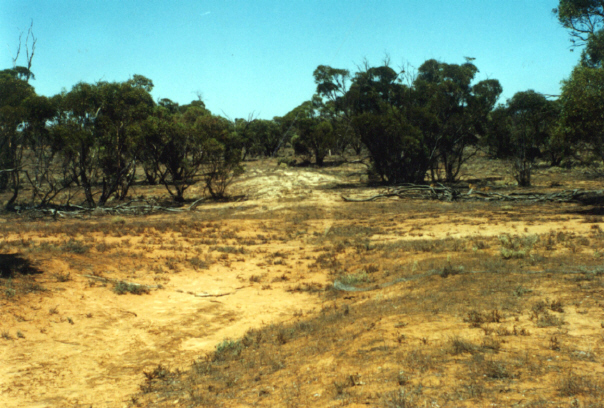
The earthworks for the proposed reversing triangle at Morkalla are still clearly visible. In this view looking towards the apex of the triangle, the up end curve and dead end can be clearly seen. The down end curve passes under the mallee scrub and fallen branches to the right. 27-2-1999. Photo: Bruce McLean
On 18-6-1931 the extension was opened without any official celebration and with the exception of some wheat lumpers, no settlers in the district attended to mark the occasion of the first official train run by the Victorian Railways Commissioners. The total cost for the extension of 9.54 miles was 32,170 pounds. At 403 miles from Melbourne, Morkalla now had the distinction of being the most distant railway station from Melbourne on the Victorian Railways system.
When the service to Morkalla commenced it was scheduled as a Mixed train to run on the first Thursday each month. "Oriel" in the Melbourne Argus newspaper published this poem on 27-6-1931.
There's a land far out near the setting sun
And the grass grows green in the sleepers bed,
And the bright new rails with rust grow red.
Then a train comes along with its "Puff, puff, puff,"
And picks up passengers and wheat and stuff;
And the residents cheer and their brows entwine
With greenery in honour of the Once-a-Month line.
Folks there are placed, and they don't e'en pout
As they reach Morkalla station as the train steams out.
For what is the use of becoming vexed?
They just sit down and wait for the next.
Or they put in a crop, which they deftly strip
Ere the train comes in for its next month's trip.
And the grain's all bagged and ready to consign
There are wide awake people on the Once-a-Month line!
The fame of the line reached Melbourne town.
And it smoothed from the Big Chief's face a frown.
As he said, with an expression of the deepest peace,
"Well, at last it's paying for it's axle-grease!"
Such a glorious achievement wasn't known before
On the spur lines built in days of yore;
And some Very High Officials drank a glass of wine
For to toast the success of the Once-a-Month line.
Ah! Happy they are of our bustling race
Who can live their lives at once-a-month pace,
Where time drags by in a restful hush,
Far from the three minute roar and rush.
Kind fate, place me, when my spirit fails,
By a grass-grown route with rust-red rails
And let my westering ways days decline,
Mid the sunlit peace of the Once-a-Month line.
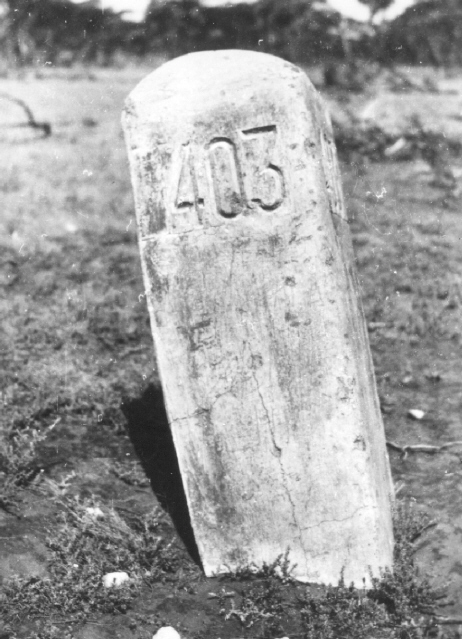
The famous 403 mile post at Morkalla photographed in July 1952. Photo: J. Charnock
To provide an idea of the type of construction standard applied to the section, the following description may be of interest:
Rails in Main Line are 60 pounds "D"; 60 pounds "C"; 60 pounds "N"; 66 pounds "E" serviceable (used) and 60 pounds New AS.
Sleepers are 8ft.6ins.x9ins.x4.5ins.Red Gum and a few Box; 9 sleepers under 22ft.6ins. and 23ft. rail; 13 sleepers under a 31ft.6ins. rail and 19 sleepers to a 45ft. rail.
Ballast is sand and limestone 4ins. under sleepers boxed up to 8½ins.
Item |
Meringur - Morkalla |
Date of start of construction |
5-6-1930 |
Date of opening for public traffic |
16-6-1931 |
Length of line |
9 miles 43 chains 29 links |
Costs |
Pounds |
Surveys |
£200 |
Clearing and grubbing |
$693 |
Fencing |
£181 |
Cattle pits |
£86 (3 No.) |
Station gates |
£76 (6 No.) |
Mile and half mile posts |
£22 (19 No.) |
Whistle posts |
£12 (8 No.) |
Caution boards |
£10 (3 No.) |
Culverts timber |
£73 |
Culverts - concrete pipe |
£61 |
Culverts - earthenware pipe |
£10 |
Earthworks, creek diversion, road approaches etc |
£3,224 |
Metalling and gravelling limestone |
£251 |
Ballasting - sand and limestone |
£2,567 |
Sleepers 8'6"x9"x4½" grey box |
£6,676 (20,906 No.) |
Crossing timber |
£88 (263 No.) |
Permanent way material |
£7,161 |
Points and crossings |
£276 |
Freight on per way material |
£1,423 |
Laying per way |
£1,471 |
Terminal station buildings and platform |
£210 |
Roadside stations |
£107 (1 No.) |
Telegraph |
£923 |
Engineering and supervision |
£3,110 |
Signals and safety appliances |
£10 |
Additions to junction station |
£400 |
Improved conditions for workmen |
£1,264 |
Tools and plant |
£1,572 |
A Fordson tractor (possibly Rail Tractor No.1) was used for ballasting.
Section |
Authorised Expenditure |
Actual Cost of Line Opened |
Redcliffs - Werrimull |
£175,000 or £5,000 per mile |
£128,983 or £3,644 per mile |
Werrimull - Meringur |
£75,260 |
£61,868 or £4,077 per mile |
Meringur - Morkalla |
£47,500 or £4,979 per mile |
£3,2178 or £3,373 per mile |
There were three ballast sidings located between Thurla and Benetook to take advantage of limestone deposits which were found to be ideal for ballast for light line construction.
A spur siding located on the up side facing up trains was established during construction of the line at 350½ miles by the Railway Construction Branch. Ballast was obtained for the section Redcliffs - Werrimull from 1922-1924 and the siding was removed before the opening of the line to Werrimull.
Ballast siding location |
Notes |
5 miles 40 chains (up side of Thurla) |
Points laid in but no material taken from this location. 1922-24? |
9 miles 40 chains (between Thurla and Benetook) |
Points laid and 18 chains of track. Limestone for Redcliffs to Werrimull section. 1922-24. |
10 miles (approx) (between Thurla and Benetook) |
Mildura Shire Council siding owned jointly with Public Works Department. 1926-32. |
10 miles 70 chains (between Thurla and Benetook) |
Staff locked points and track. Limestone for Werrimull to Meringur section. Siding dismantled at end of work. 1925. |
24 miles 40 chains (down side of Merrinee) |
Points laid and 20 chains of track. Sand for Redcliffs to Werrimull section. 1922-24. |
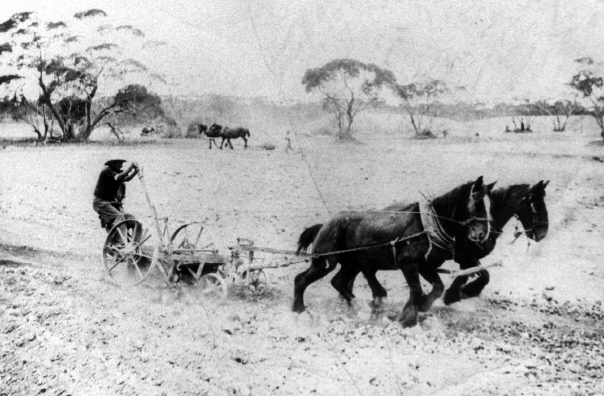
"The Chinaman" breaking up limestone for ballast at the 9 mile 40 chain ballast reserve. Photo: D.C. McKay Collection
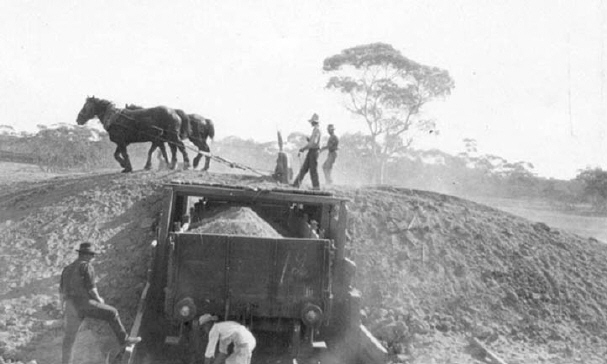
A horse pulled scoop empties another load of limestone into a waiting QR ballast wagon at one of the two limestone ballast sidings. Photo: Wilf Henty, courtesy John Kiely
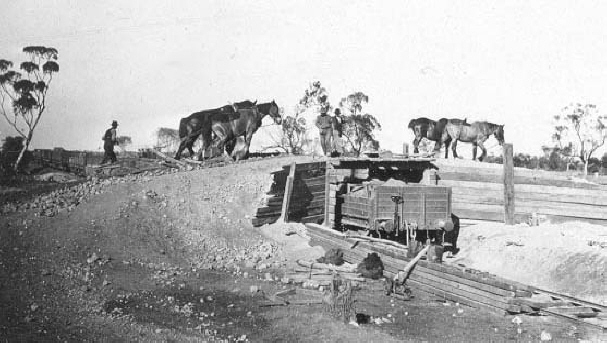
Another fine view of ballast loading. Note the long rake of wagons to be filled. Photo: Wilf Henty, courtesy John Kiely
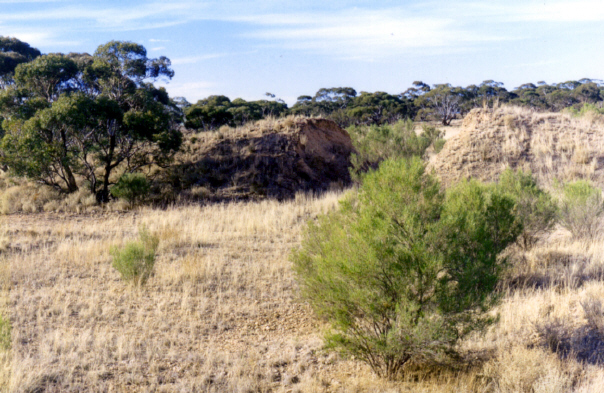
The remains of the loading ramp used for the first limestone ballast siding at 9 miles 40 chains beside the abandoned formation of the Morkalla line. 4-6-2001 Photo: Bruce McLean
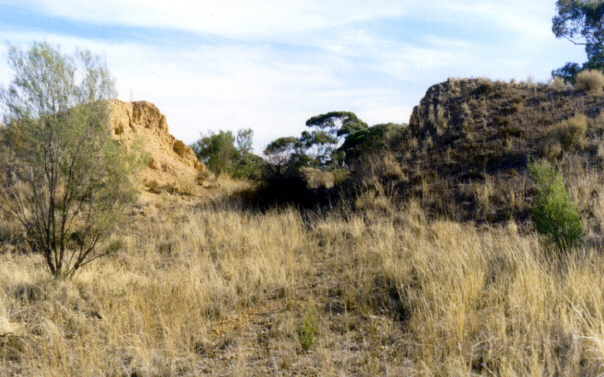
Another view of the loading ramp remains on 4-6-2001. The abandoned formation of the Redcliffs to Morkalla line is next to the tree in the background. Photo: Bruce McLean
A spur siding was established at 10 miles 70 chains by the Railway Construction Branch on 8-9-1925 to obtain ballast for the construction of the extension from Werrimull to Meringur. It was closed and removed soon after the extension was opened on 30-10-1925.
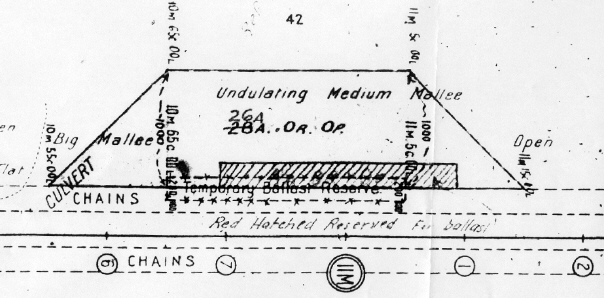
Plan showing the ballast reserve at 10 miles 70 chains between Thurla and Benetook. Source: Bruce McLean Collection
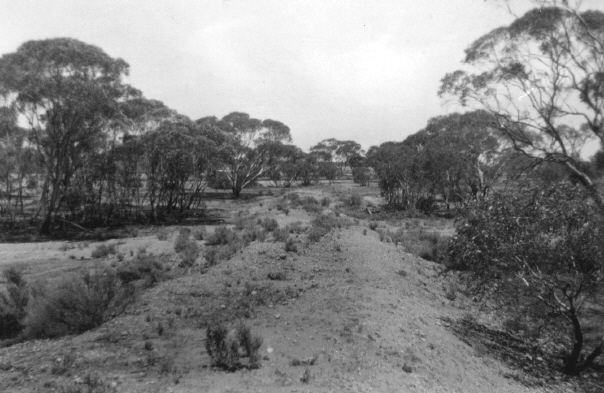
Embankment leading from the main line (visible through trees in centre of picture) for the second limestone ballast siding at 10 miles 70 chains provided to obtain ballast for the second section of line, Werrimull to Meringur. Photo: Bruce McLean
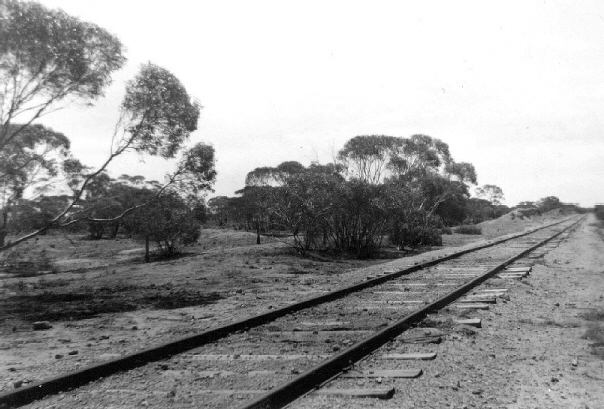
The point of divergence facing up trains for the second ballast siding used for the Werrimull to Meringur extension. This view is looking in the opposite direction from the previous picture. Visible to the right of the picture is the remains of the loading bank for the third ballast siding used by a consortium requiring limestone for railway ballast and road making. Photo: Bruce McLean
A loop siding was opened at 351.5 miles on 5-3-1926 for the Mildura Shire Council in joint ownership with the Public Works Department and used by the State Rivers and Water Supply Commission and Country Roads Board to load limestone into rail trucks. Ballast was sourced from this site for use on the Mildura main line during relaying with heavier rails and construction of the extension from Meringur to Morkalla. The siding was closed on 15-3-1932 but was not removed until October 1940.
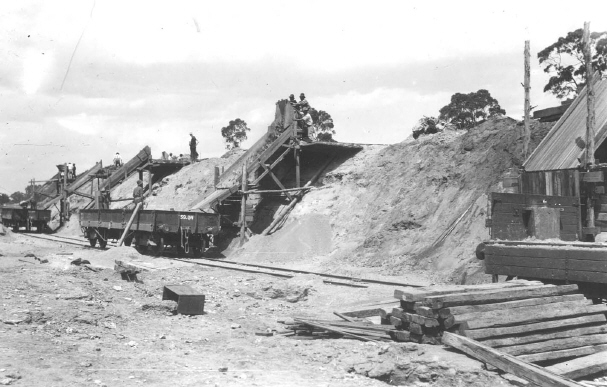
Loading QN Class ballast wagons at the Mildura Shire Council, State Rivers and Country Roads Board ballast siding near Benetook. Date unknown. Photo: Wilf Henty, courtesy John Kiely
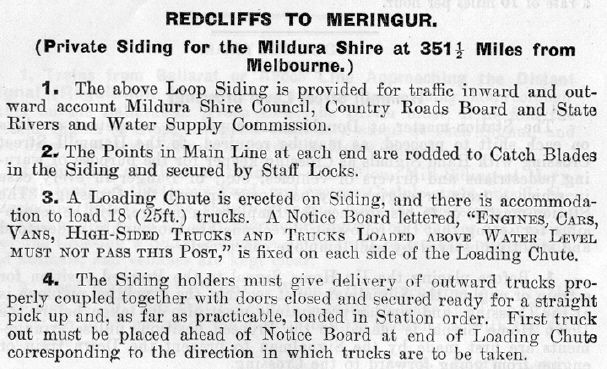
Instructions issued in the 1928 General Appendix for the Mildura Shire Council siding between Thurla and Benetook. Source: Victorian Railways
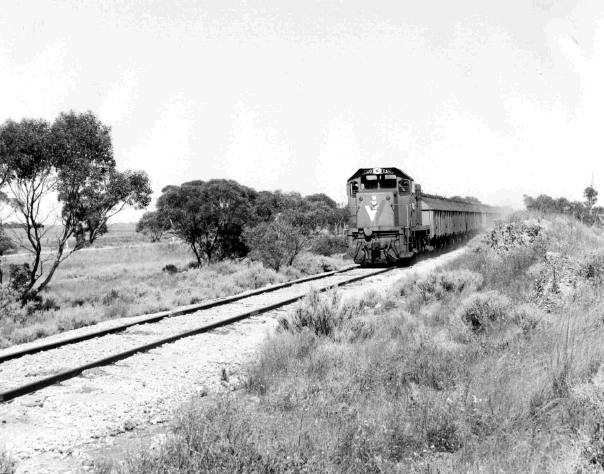
T370 with a loaded train of GH wagons passes the site of the third ballast siding and remains of the loading embankment constructed for ballast and road making use. Photo: Chris Wurr
In 1932 there was a change of government in Victoria and this prompted the Renmark Railway Committee to revive the proposal for the extension of the railway from Morkalla to Paringa on the Tailem Bend - Barmera line in South Australia, about 25 miles distant. There appeared to be little interest from Millewa farmers who were well pleased with their existing facilities connecting them with Melbourne and the southern ports.
In June 1941 the Minister for Transport (Mr. Hyland) gave notice to the Legislative Assembly that he intended to bring a Bill to dismantle portion of the Nowingi to Millewa South railway and it was suggested that the materials recovered could be used to construct an extension of the Morkalla line to Paringa.
The arguments presented in favour of the proposal were that district growers would save with freight charges on fruit; the route would provide a viable inland alternative interstate rail link; and decentralisation of industry would be assisted. It was also anticipated that Mildura would be producing articles for Australia's war effort and the connection would speed the supply of raw materials.
The Premier of South Australia (Mr. Playford) advised that the South Australian Railways Commissioner did not consider the scheme would be a payable proposition and there was no interest shown by the Victorian Railways.
Thurla was the closest station to Redcliffs, however it saw little traffic during its life and was closed on 7-12-1953.
During 1955 the Minister for Transport (Mr. Warner) advised Mr. Nat Barclay M.L.A. for Mildura that closing the 10 miles section between Meringur and Morkalla was being considered because the amount of traffic did not warrant its continuation. A deputation of local residents met the Commissioners at Meringur on their next annual visit to protest at the planned closure. The Commissioners stated that no decision on the future of the line would be made for some time, although continuation of the service was under review. The section was not carrying enough traffic to justify the existing service and an option was to limit the service rather than close the line entirely.
In November 1956 it was reported at a Mildura Shire Council meeting that the Victorian Railways were proposing to let stock loading races and pens at Benetook, Pirlta, Merrinee, Karawinna, Werrimull, Bambill, Yarrara, Karween and Morkalla "go to destruction". Meringur would be the only siding along the line where stock loading facilities would be retained. Only 40 trucks of livestock had been freighted along the line in the last 12 months. The Shire had been discussing a letter from the Upper Murray Local Government Association of South Australia who was seeking the support of the Shire in a move to have the Morkalla line extended into South Australia. Mildura Shire decided to support the Association's move.
In February 1958 the Chairman of Commissioners (Mr. Brownbill) announced that the Meringur -Morkalla section would be closed unless usage improved. No further action was taken however, and when the Commissioners visited the area during their May, 1959 inspection, Mr. Brownbill stated that the 10 miles section would be kept in good repair to enable wheat to be consigned from Morkalla during the 1959 harvest.
On 27-5-1959 it was announced that the goods service to Morkalla would be discontinued after the running of the train to Morkalla the following Tuesday 2-6-1959. The line would remain open for the cartage of wheat only and trains would be run only as required for this purpose. General traffic was very light and the only freight movement of any consequence was of grain during about four weeks of the harvest season.
The last train was run by K190 with Driver T. Ball and Guard, R. Bode.
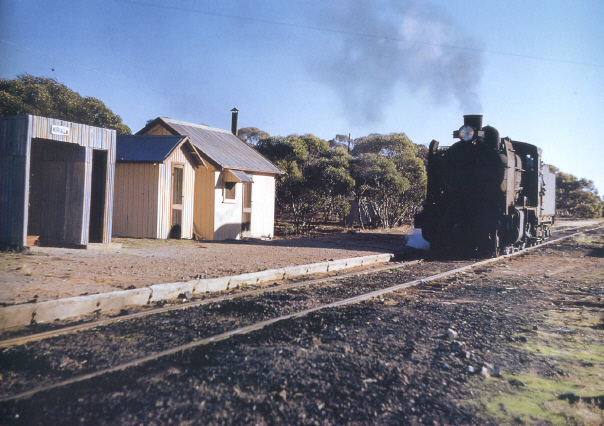
A K Class locomotive stands at Morkalla station in 1959 shortly before the cessation of services beyond Meringur on 2-6-1959. Photo: Peter Ralph, courtesy Train Hobby Publications
The end was nigh however, as the Meringur branch of the Wheat and Woolgrowers Association advised Mildura Shire Council that the Victorian Railways had refused to cart wheat from Karween and Morkalla for the 1961 harvest.
The Meringur to Morkalla extension was closed to all traffic from 19-3-1964. When the Commissioners visited Mildura for their annual inspection tour on 25-11-1964 Mr. Brownbill informed Mildura Shire councillors that the line had been closed because of lack of use. The Shire President (Mr. E.Wolfe) told Mr. Brownbill that wheat and woolgrowers wanted the line open and would also like to see it extended into South Australia. Mr. Brownbill said that it was the wheat and woolgrowers who failed to use the line to its full extent. Only 130 wagon loads of wheat were carted on the line the previous year and this was not good enough.
The Minister for Transport (Mr. Meagher) announced in December 1964, however, that the Meringur - Morkalla section had been reprieved and no action would be taken "for the time being" to dismantle the track, pending investigations by the State Development Committee of a possible extension west of Morkalla. The line would not be reopened for the present grain harvest because the Grain Elevators Board estimate of truckings showed that less wheat would be available for loading than last season. On 16-11-1965, prior to the grain harvest of that year, the line was "officially" closed and a long dormant period began.
The consequences of a severe drought in 1968 created high unemployment and State government funds were made available for drought relief work. Mr. Whiting M.L.A. for Mildura recommended that strengthening of the Meringur - Morkalla line be undertaken as a project. This work would be necessary before the Grain Elevators Board would build a bulk storage at Morkalla.
In December 1966 the Mildura Shire Council asked the Victorian Railways to reopen the section. Council advised that 28,000 acres of wheat were being harvested at Morkalla and this wheat had to be taken to the Grain Elevators Board storage at Meringur. The storage also had to cope with the grain from 33,000 acres sown in the Meringur district. Mr. M. Whiting M.L.A. also sought drought relief funds to upgrade the line from Meringur to Morkalla.
It was obvious however, that the reopening of the line would be dependent upon the Grain Elevators Board constructing storage facilities at Morkalla and after an approach by Mr. Whiting to the Board, the Chairman (Mr. Turnbull) said that the Board would not consider Morkalla as a site for a silo whilst it did not have adequate rail facilities!
Things livened up at Morkalla in March 1970 when an oil drilling rig was erected a short distance from the railway station. Sunraysia Daily claimed that the rig would bring "new and sudden life" to "what is now little more than a ghost town". The venture, however, came to nothing. The weighbridge shed, complete with most of its equipment still intact and the railway yards with the platform - without any buildings - and collapsing stockyards, remained as reminders of days that might have been.
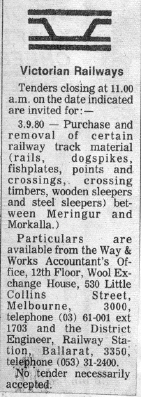
Tender advertisement published in "Sunraysia Daily" on 13-8-1980. Source: Bruce McLean Collection
The line remained dormant until tenders for the purchase and removal of the railway between Meringur and Morkalla were advertised in August 1980, and again in July 1982. By this time, the wooden sleepers were rotting and mallee scrub had grown to a large size where it had taken a foothold between the rails.
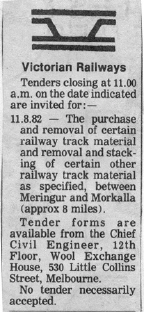
Repeat advertisement in "Sunraysia Daily" on 7-7-1982 for tenders to dismantle track from Meringur to Morkalla. Source: Bruce McLean Collection
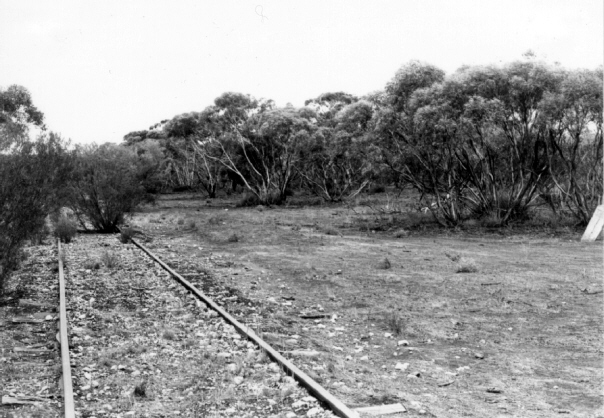
Overgrown track near Meringur at the 394 mile post (far right of photo) on 2-10-1977 - 16 years after the last train on the Meringur to Morkalla section of line. Photo: Bruce McLean
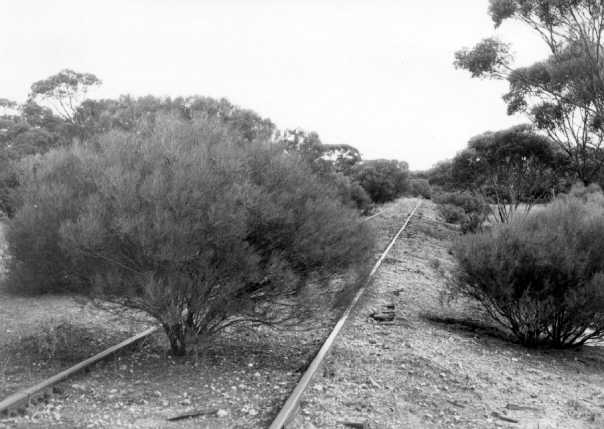
A mile further on at 395 miles and another four years after the previous scene. This view is looking towards Karween in the down direction in May 1979. Photo: Bruce McLean

End of the line at Meringur. The closed section of line to Morkalla continues beyond the baulk. 21-12-1980. Photo: Bruce McLean
The successful tenderers were C.S.R. Limited (Brunswick Plaster Mills) who tendered for one mile for use on the Nowingi branch to their gypsum mine. In 1982, Mr. R.Rankin, a Millewa farmer, successfully tendered to remove the remaining section. Mr. Rankin saw the sale of the salvaged materials from the rest of the line as a replacement for a drought-affected grain crop.
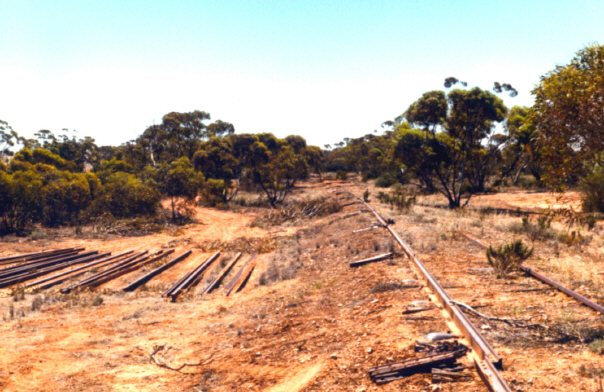
Dismantling the first mile of the track beyond Meringur was undertaken by the Brunswick Plaster Mills from Nowingi who required the 60 pound rail to maintain their track for gypsum haulage. 21-12-1980. Photo: Bruce McLean
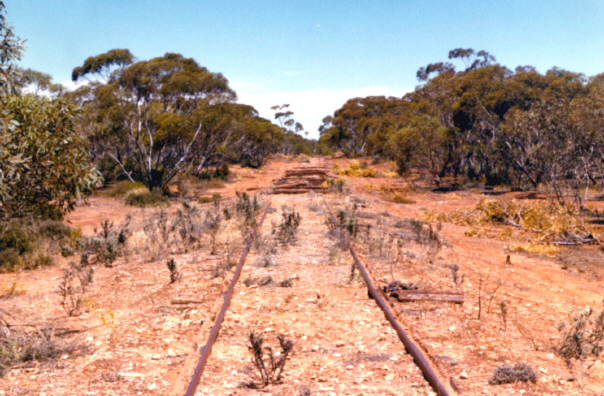
Another view of the Meringur to Karween section with track dismantling underway. 21-12-1980. Photo: Bruce McLean
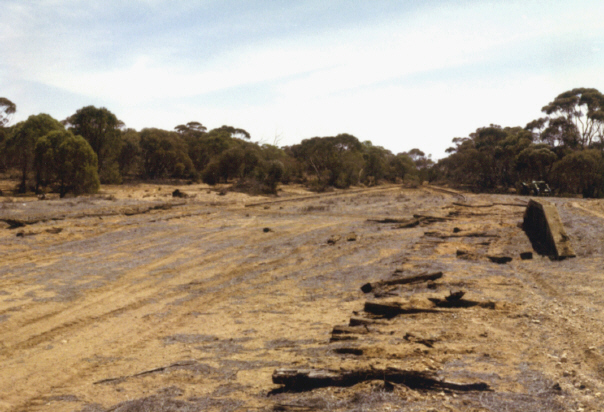
Track dismantling at Karween. Some rails have yet to be lifted from the main line and siding. 13-11-1982. Photo: Bruce McLean
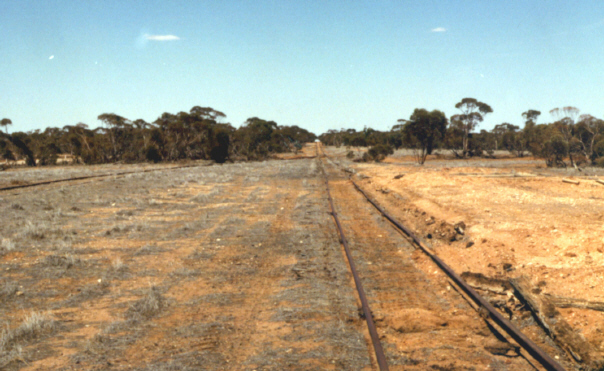
Morkalla station platform and yard with track dismantling underway with the removal of dog spikes on 13-11-1982. Photo: Bruce McLean
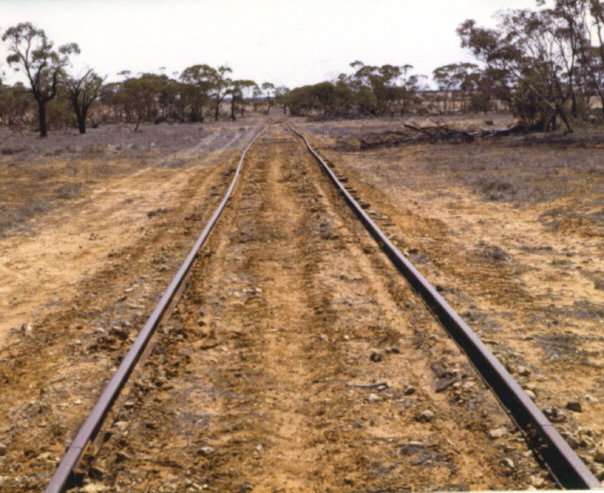
Looking westward to the end of the line at Morkalla on 13-11-1982. The dog spikes holding the rails to the sleepers have been removed. Photo: Bruce McLean
Following a study of the traffic handled, the Victorian Railways announced that the Red Cliffs - Meringur line would be closed seasonally from 6-10-1972 until December and from about June to December in the following years. The Chairman of Commissioners (Mr. Brown) said that the study found that during July to December the total tonnage of goods offering was very small and did not justify running a goods train. The seasonal nature of the traffic required a service during the other half of the year to handle grain and superphosphate in particular. The actual date of temporary closure and reopening would be dependent on clearance of elevators and commencement of movement of the new season's grain and supply of superphosphate.
Workmen employed under a Regional Employment Development scheme commenced a program in June 1975 of replacing unsuitable sleepers in the line from Red Cliffs to Meringur.
Cr. L. Fraser, a Mildura Shire Councillor and wheat farmer, speaking in July 1977, claimed the Red Cliffs to Meringur line was rarely used and uneconomical and should be closed. He favoured retention of the silos but use of road transport for grain and superphosphate. By closing the Meringur line, the Yelta line could be kept open.
The Millewa District Council of the Victorian Farmers' and Graziers' Association (VFGA) were "up in arms" over these comments. The secretary, Mr. S. Pickering, said that members were appalled at the "irresponsible" statements claiming that it would be impossible for road transport to handle a normal harvest on the existing shire roads.
Cr. Fraser apparently reconsidered his views as he proposed at a Mildura Shire Council meeting on 1-6-1978 that the Shire approach the Commonwealth and South Australian governments for comments on a proposal to extend the Meringur-Morkalla line to link up with the South Australian railway system. Cr. Fraser claimed that a large volume of produce from the Millewa area was already going to South Australia. The Australian National Railways Commission responded to the Mildura Shire Council in September 1978 stating that a rail system serving the Riverland and Mildura could be of benefit but its prime concern with such a proposal was the profitability and viability of the connection.
The Minister for Transport (Mr. R. Maclellan) and the general manager of the Grain Elevators Board (Mr. I. Stoney) inspected the Millewa line with district parliamentarians on 10-1-1979 meeting with growers and inspecting the receival of grain to silos and the transfer to railway wagons. The Minister was told that insufficient rail trucks could be held at some stations because the length of sidings were too short and the permanent way was not strong enough to take modern grain wagons. The Minister was told that the Millewa line earned about one million dollars in revenue and he acknowledged that a line earning revenue has to be maintained to make sure of that revenue.
However, as happens when Ministers go "back to their office" Mr. Maclellan wrote to Mr. Whiting M.L.A. in February 1979 stating that it would cost an estimated $3.5 million to upgrade the Redcliffs - Meringur line, but there were other lines in the state which had a higher priority. The major problem was the 60lb. rails which were not strong enough to operate bogie wagons at 50kmh.
Mildura Shire Council, at its meeting on 10-1-1980, called for construction of new railway connecting Yarrara and the Riverland railway system in South Australia. Cr.K.Coogan, a farmer from Werrimull, claimed that it was more important for farmers in the area for a link with Adelaide seaport than the existing connections to Portland and Geelong. The discussion was in response to a request for support from the Balmoral Western Victoria Transport Committee seeking support for upgrading the Noradjuha-Balmoral-Hamilton rail line.
At the same meeting, a letter from the Director General of Movements and Transport, Department of Defence, Canberra, indicated support for extension and development of railways as the most effective means of moving large quantities of supplies at the greatest efficiency, but considered the defence potential of the Red Cliffs to Morkalla line, even with an extension linking with the Loxton to Adelaide line, could not be supported by defence requirements.
Mildura Shire Councillors K.Coogan and L.Fraser, who represented the Millewa wheat growing area, gained the support of their council in pressing for upgrading of the line from Red Cliffs to Meringur when they met the Deputy Chairman of the Victorian Railways Board, Mr. I. Hodges at Mildura on 14-10-1980. However, Mr. Hodges pointed out that the whole of the line could be phased out in the future with the establishment of major grain receival depots on main lines to speed up rail operations and reduce costs. With modern road trucks it wouldn't cost farmers much more to deliver their grain to terminals set up on the main lines.
Mr. Hodges visited Meringur and indicated that whilst some re-sleepering was being done along the line there were no plans for immediate upgrading of the line.
The annual meeting of the Millewa branch of the VFGA carried a resolution calling on the government to retain and upgrade the Red Cliffs to Meringur and Mildura to Yelta lines with central receival points for grain established at Meringur, Merrinee, Yelta and Carwarp. Mr. S. Pickering, a local farmer and VFGA representative on the State Transport Authority, encouraged farmers to keep fighting for retention of the line.
Canac Consultants Ltd. from Montreal, Canada, were appointed in 1984 by the State Transport Authority, Grain Elevators Board, Australian Wheat Board and the Ministry of Transport, to study and advise on the most cost effective method of moving the State's grain harvest from farms to ships and domestic users.
The consultants recommended the introduction of 29 centralised receival points for Victoria's grain including the southern region of New South Wales. Options in the report recommended the abandonment of the Red Cliffs - Meringur and Mildura - Yelta lines, leaving silos to be cleared by road to a new central receiving point at Red Cliffs or Carwarp. Grain would be picked up from farms by road transport and this immediately raised concerns by the Shire of Mildura about the upgrading of roads to carry the additional heavy traffic that would be generated. Mildura City Council also reacted to the effect on the city road system.
The Minister for Transport, Mr. T. Roper released the interim report on Victoria's grain handling in October 1985 confirming closure of the Meringur and Yelta lines and offering interested groups three months to comment. Immediate concerns identified by Millewa farmers were the effect on the road system and the amount of money, estimated at $152,000 a kilometre, to construct a two lane country highway capable of taking heavy wheat trucks. It would cost $82,000 a kilometre to upgrade the existing railway line.
One reaction by Millewa farmers was to ask the South Australian Bulk Handling Authority to allow them to transport grain by road to South Australian ports. Five thousand tonnes of the Millewa's 60,000 tonne grain crop went by road to Port Adelaide or Wallaroo last harvest and that figure was expected to treble, costing Victoria about $350,000 in lost revenue.
A meeting at the Werrimull hall on 8-11-1985 called by the Millewa District Council of the VFGA, attended by 120 district people, was told by a representative of the South Australian organisation that farmers could qualify for a large freight discount if they would give a guarantee to ship all their wheat through the South Australian (Australian National) rail system. The rail freight charge per tonne from Loxton would be about $13 a tonne compared with the Victorian rail and handling charge of $20 per tonne.
Mr. R. Wilkinson, President of the Millewa district council, raised the concern that if Victorian silo facilities were not used, they would fall into disrepair. It was also pointed out that the GEB had spent $4.6 million developing Millewa grain silos. The meeting resolved to give total support to GEB facilities in the district and called on the marketing authorities to secure the most economical means to get grain to the seaboard.
An early response to the threat to move grain interstate came when the Minister for Transport (Mr.T. Roper) advised that concession rates had been negotiated for the Yelta, Meringur, Panitya, Serviceton and Yanac areas. In a move claimed "to be the first time in the history of the Victorian grain system" it was announced in September 1986 that freight rates would be reduced between 4 and 20 percent across the State with rates at Carwarp (-7.91%), Werrimull (-2.33%) and Yelta (-4.12%). Ouyen and Underbool remained unchanged.
The Ministry of Transport advised in November 1986 that the Red Cliffs - Meringur line was to close, however it would continue to be used until it was unsafe to run trains. (The Minister for Transport announced at the same time that $14.3 million would be spent to upgrade the Manangatang to Robinvale, Woorinen to Piangil and Mildura to Yelta lines. Other lines proposed for closure were Jeparit to Yanac and Hopetoun to Patchewollock).
Mr. R. Hards, Secretary of the Millewa District Council of the Victorian Farmers' Federation, (VFF - formerly VFGA) expressed concern at the ability of the road system to stand cartage of grain to the Carwarp silo if the line closed and sought government funding for road upgrading. A second option was to maintain and upgrade the railway as far as Werrimull with road upgrading to Meringur. The Minister for Transport gave an assurance that roads would be upgraded and maintained at no cost to growers or the Shire of Mildura.
Following the closure announcement, grain movements to South Australia escalated and it was estimated by the VFF Millewa District Council that 40,000 tonnes of grain would be lost to Victoria by the end of the 1986 season. Some growers were finding it cheaper to have grain picked up directly from the farm. It was estimated that at least 30 Queensland semi- trailers were carting grain from mallee farms to Adelaide.
The Premier (Mr.J.Cain) and the Minister for Agriculture and Rural Affairs (Mr.Walker) visited Ouyen on 6-1-87 to inspect the extended GEB facility and dismissed the loss of grain to South Australia as a "phenomenon peculiar to this (north- west) corner of Victoria". Rail freight charged had already been cut by 13 percent and would not be reduced any further.
An urgent requirement for 340 tonnes of barley for loading at Portland by V/line road contractors on 14-9-1987 provided an early indicator of the effects of the rail closure. Trucks with 40 tonne loads were using the parallel roadway with a load limit of 20 tonnes and a pavement only 12 feet wide causing concern to the Shire of Mildura. Mr. Whiting M.L.A. was irate that V/Line had decided it was quicker to move the barley by road from Meringur to Carwarp instead of rail and the way the Shire of Mildura was treated. (Mr. Whiting subsequently learned that it cost $2 per tonne more than normal costs for the movement). Both Mr. Whiting and the Mildura Shire Engineer, Mr. D. Kirby, said the hit-run operation was a foot in the door for permanent road haulage in the Millewa where there was an average grain movement of around 100,000 tonnes a year. Mr. Whiting called on the government to review its decision to close the line and upgrade the existing rails with bluestone ballast or limestone obtained locally.
A decision on the future of the line was deferred in May 1988 pending a ministerial submission from the VFF. A meeting of wheat growers at Werrimull on 26-5-1988 met with Mr. M. Whiting M.L.A.. Mr. Whiting reported that 120 loaded truck trips a day would be required to move wheat to Carwarp or South Australia at a cost of $7.00 a tonne, if the line was closed. In five years that would pay for the cost of rail upgrading.
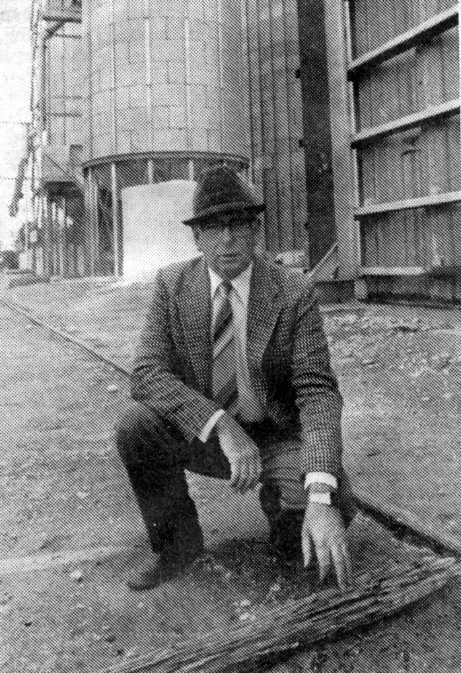
Mr. M. Whiting, Member for Mildura, at Yarrara during his relentless campaign to save the Meringur railway from closure. 26-5-1988. Photo: Sunraysia Daily, Bruce McLean Collection
The Minister for Transport (Mr. J. Kennon) visited Mildura on 15-6-1988 to meet a delegation consisting of Mr. Whiting, Victorian Farmers Federation representatives and Mildura Shire Council. It was reported that he was sympathetic to farmers relying on the line for grain transport and was more aware of the complex issues involved. In the meantime there were no trains scheduled and services were suspended.
The National Party transport spokesman, Mr. W. McGrath gave an "assurance" that the Meringur line would not be closed by a coalition government when he visited the area on 16-9-1988 however this was difficult to reconcile with new fast fill facilities for grain being constructed at the Carwarp silo specifically to handle incoming grain from the Millewa. It was however, an election climate and Mr. McGrath was campaigning on behalf of National Party hopeful for the seat of Mildura, Mr. J. Arnold.
V/Line announced on 7-10-1988 that it was canvassing farmers in the Millewa area to use their on farm pick up service to provide a paddock to port option. Grain would be carted from farms to central receival points at Carwarp or Yelta.
Grain delivery incentives were announced by the Grain Elevator's Board on 11-11-1988 for the 1988/89 season. The incentives varied for wheat and barley and were only available in the north western region of Victoria at silos along the Ouyen to Panitya line, Redcliffs to Meringur line as well as at Speed, Carwarp and Yelta. The incentives were developed with the view of retaining Victorian grown grain in the Victorian handling and storage system. V/Line contributed financially to the operation of the grain delivery incentive scheme because of the revenue benefits received and was supported by the trial pick up service on the Meringur line.
By 25-11-1988, V/Line, through an operational centre set up at Werrimull, had persuaded 62 out of 142 grain farmers to use the new pick up system. During November every grower in the district had received a visit from a V/Line representative. Although denied that the scheme was intended to ensure the closure of the Redcliffs to Meringur line, the Group General Manager of Freight Services, Mr. D. Murphy, claimed that it was a matter of "lets try something different this harvest and see if it works".
It worked. The Meringur line was officially closed on 9-12-1988, the Shire of Mildura being given instructions by V/Line in April 1989 to seal bitumen over all level crossings (even dirt and gravel crossings).
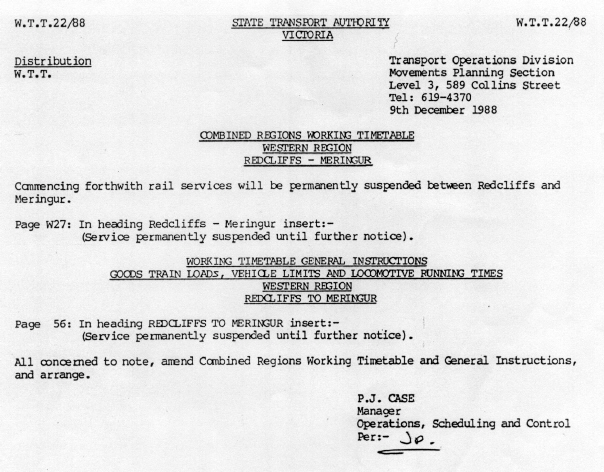
Circular issued for permanent suspension of the Redcliffs to Meringur line from 9-12-1988. Source: State Transport Authority
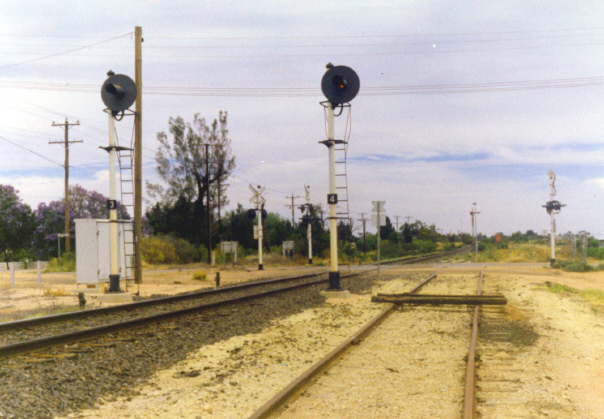
Baulk placed before the Murray Avenue level crossing, Redcliffs, marking the closure of the Meringur branch line to rail traffic. 4-12-1989. Photo: Bruce McLean
Tenders were called by the Public Transport Corporation in April 1990 for the dismantling, salvage, purchase and removal of the Red Cliffs to Meringur line.
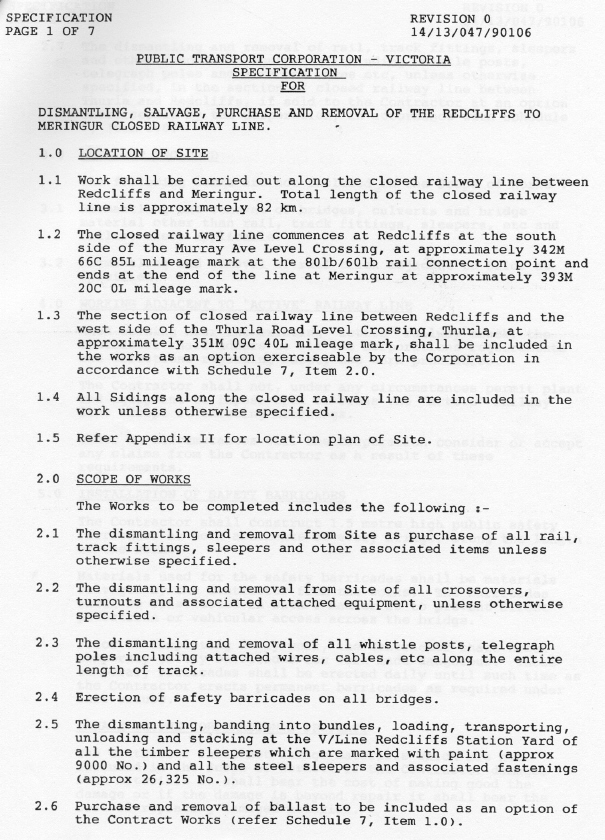
Page from the Tender Document for dismantling the Meringur line. Clause 1.3 alludes to the retention of the section from Redcliffs to Thurla pending a decision on purchase of the line for use as a tourist railway. Source: Bruce McLean Collection
Dismantling of the Red Cliffs to Meringur section of the Morkalla branch line commenced on Monday 19-6-1990 and was completed by the end of February 1991. The contractors were Prestal Pty. Ltd. with sub-contractor MGS Timber, a company associated with MGS garden supplies.
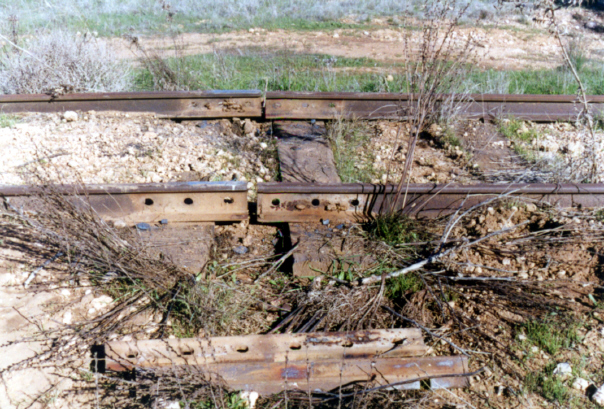
The start of dismantling the Meringur line was at a point near the Koorlong Road level crossing near Thurla on 19-6-1990. The fishplates have been removed and dismantling commenced immediately on the right hand rails leading to Meringur. Photo: Bruce McLean
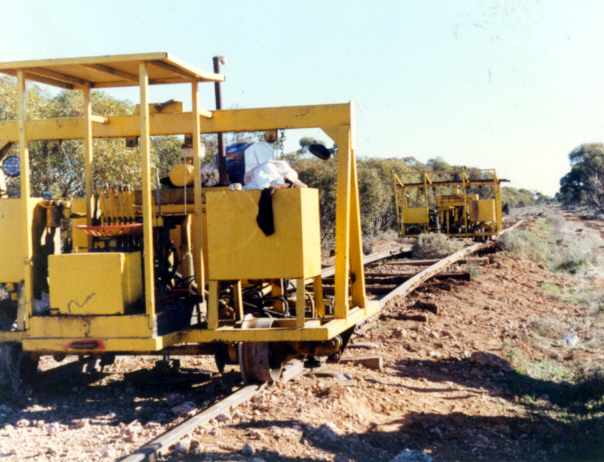
Special track mounted machines were used by the contractors to lift the track and release dog spikes from sleepers as work started on dismantling the Meringur line. 19-6-1990. Photo: Bruce McLean
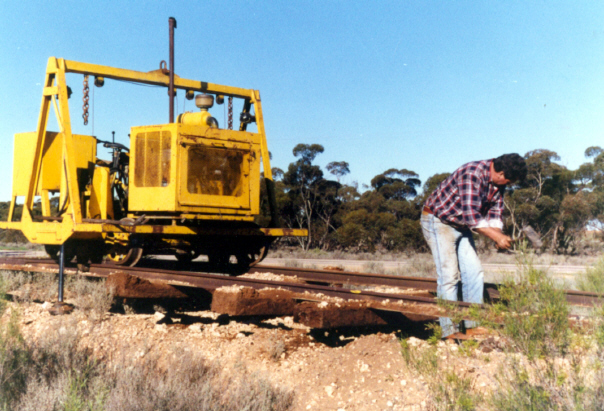
Dismantling the track between Thurla and Benetook. One of the conditions of the contract was the retention by the State Transport Authority of specified wooden sleepers and all steel sleepers. 20-6-1990. Photo: Bruce McLean
Thousands of sleepers from the line were bound for Melbourne suburban gardens whilst the future for most of the steel rails was in Mackay, Queensland where they were re-used for upgrading sugar cane tramways. Some rail was sold locally from advertisements in "Sunraysia Daily" for 60 pound x 45 foot lengths of rail for $2.50 per foot loaded on transport. Other advertisements appearing in local newspapers were calling for tenders for the cartage of bulk grain from silos along the line to Carwarp. Dismantling of the line was completed at the end of February 1991.

Part of the contractor's contract for dismantling the Redcliffs to Meringur line, was to store wooden and steel sleepers in the Redcliffs goods yard for future use by V/Line. About 9,000 wooden sleepers and 26,325 steel sleepers and fasteners were retrieved from the line. 11-3-1991. Photo: Bruce McLean
The Rotary Club of Red Cliffs and Sunraysia Steam Preservation Society asked the Shire of Mildura to obtain a nine kilometre section of the line between Red Cliffs and Thurla for a tourist railway using the former State Rivers and Water Supply Commission narrow gauge locomotive that had recently been restored by the Steam Preservation Society. A section one mile long was purchased by the Shire in September 1990 for $20,000. The Rotary Club applied to the Shire of Mildura to lease the south west reserve area for a period of ten years with a ten year option. The Rotary Club also auspiced the formation of the Red Cliffs Historical Steam Railway Incorporated and following construction of an oval of track around the South West Reserve tennis courts and conversion of the broad gauge track to 2 foot gauge, the tourist railway commenced operations in 28-9-1997.
The Millewa Community and Pioneer Forest at Meringur recognised the importance of the railway that served the area by obtaining a small section of rail from the contractors dismantling the Meringur station yard and arranged for the acquisition of a surplus Way and Works vehicle, HD224, to be preserved. HD224 was originally in service as an ABL swing door passenger carriage. Five electrical plant trucks were built using ABL bodies that had been cut in half. One of these half carriage bodies was placed on the underframe of former wagon IA 8899 and issued to traffic on 14-10-1966 as electrical plant truck HD224.
The same group also obtained the Carwarp station building, a 20 x 12 foot portable building, and it now forms as a valuable reminder of one of the smaller stations on the Victorian Railways system.
| << Back | Home | Site Map | Copyright © 2003 Bruce McLean, All Rights Reserved |